– Detailed 2018 Gold Wing Tour Review / Buyer’s Guide: Prices, Release Date, Colors, Package Options + More! –
– Everything you Need to know about all of the 2018 GoldWing VS 2017 GoldWing Changes & Upgrades –
Today is a special day… Why is that? (If you haven’t checked it out yet, here’s the 2018 Gold Wing Announcement from earlier) It’s not often that we get to see an all-new Gold Wing announced from Honda with so many changes from front to back, top to bottom etc. I’ve been with Honda for over a decade now and this is my first time being around the Gold Wing as she goes under the knife this heavily if that gives you any idea as to how much of a rarity this is. The slight refresh the Wing received back in 2012 when it was plucked out of being manufactured in the USA to head back over to Japan just wasn’t enough. At that point the Gold Wing was aging and not aging very gracefully at that, if I’m being honest. Technology wasn’t being nice to her as her last big overhaul was in 2001 when she went from the GL1500 generation to the current GL1800 generation you’re familiar with. Thankfully Honda saw this and put the plan in motion shortly after finding out that the refresh wasn’t going to hold her over for long and customers were jumping ship to competitors that offered technological bells and whistles that the Wing just wasn’t capable of offering.
Honda is back though and as you can tell from the changes thrown at the 2018 GoldWing compared to the 2017 Goldwing as well as the slight hints in the commercials and advertising you’ll see below is that Honda is trying to knock it out of the park with the younger crowd. Gone are the days that the Gold Wing is labeled as an “old man’s bike”. Well, maybe not gone just yet as it’s going to take some much needed marketing support to get the Wing in front of younger eyes and to try and get them past that initial thought of what they might think the ‘old’ Gold Wing was. I’m not a young guy by any means any more (sadly) at 32 but still have never been a big fan of the styling that the Wing offered. There’s no getting around the fact though that the bike does not feel like an “old man’s bike” the second you throw a leg over it and hit the mountains as it’s basically a big sport bike when you strip it down to the frame. The styling and fact that it had absolutely no technology in a tech-driven world is what hurt it in the younger guy’s eyes in my opinion. I think the tides have changed though when it comes to those key points which is why I think that Honda may have a huge hit on their hands here with the 2018 Gold Wing and Gold Wing Tour models. I guess I should start calling them by their correct names now since the “Gold Wing” is now the stripped down model that is replacing the F6B for 2018 and the “Gold Wing Tour” is the model we have known for the last few decades as the ‘real Gold Wing’.
Enough of my rambling though, let’s get to why you’re here and that is to find out more details and all of the nitty-gritty specs about the 2018 Gold Wing Tour…
This page will be covering the 2018 Gold Wing Tour and GoldWing Tour DCT models. I will have a separate page that breaks down the stripped-down 2018 Gold Wing model that will be replacing the F6B and F6B Deluxe for 2018.
– 2018 Gold Wing VS Gold Wing Comparison Video –
- 2018 GoldWing Review Contents:
- 1. Introduction
- 2. Model overview
- 3. Key features
- 3.1 Styling & Equipment
- 3.2 Chassis
- 3.3 Engine
- 3.4 Manual Transmission
- 3.5 DCT (Dual-Clutch Automatic Transmission)
- 4. Technical Information Breakdown
- 4.1 Design
- 4.2 Engine
- 4.3 Technology
- 4.4 Suspension
- 4.5 Chassis
- 5. By the Numbers
- 6. Quick Overview of Features (if you’re in a hurry, skip to here)
- 7. Accessories
- 8. Technical Specifications
1. 2018 Gold Wing Tour | Introduction
The Honda Gold Wing, since its introduction as a naked 1000cc machine in 1975 has always been the ultimate in two-wheeled travel. And it’s a motorcycle that’s been very much on its own journey, growing in physical size and displacement over the decades, all the while creating an enduring and unrivaled reputation for luxury, quality and comfort.
Now, in response to the evolution of demographics and the motorcycle market, the development team in charge of the bike’s future have decided on a radical departure from what would be a traditional update trajectory.
So for 2018 the GL1800 Gold Wing takes a new direction and is brand new from the wheels-up. It still has an evocative, flat six-cylinder engine that delivers an avalanche of torque and power, and it still remains Honda’s flagship premium touring motorcycle, loaded with features that allow two people to ride in style. Yet it’s smaller, much lighter and much more agile – very much a true ‘rider’s motorcycle’.
And as a result the new Gold Wing’s appeal is broader, reaching out to a younger generation of motorcyclists that may have overlooked – or simply not been aware of – the previous design. As happy on an urban commute as it is the open road, the Gold Wing is now a bike for all reasons, rather than just one.
Mr Yutaka Nakanishi, Large Project Leader (LPL) 18YM GL1800 Gold Wing
“We wanted our new Gold Wing to maintain its luxury but to be a much more ‘rounded’ motorcycle. A machine as useful to its owner around the city as it is out on tour. And more exciting to ride than ever. So we started from a blank piece of paper and made the Gold Wing smaller and lighter, and added all the technological hardware and software the modern rider could wish for. Now, just as in 1975, it remains a flagship model for Honda – and we are very proud to start this new chapter for such an important name.”
2. 2018 Gold Wing Tour | Model Overview
Sharing a common engine and chassis platform, the new ‘Wing will be available as the base model GL1800 Gold Wing, and as a ‘Tour’ edition with top box, which will also offer a version equipped with DCT and air bag. Depending on the variant, over 90 lbs has been shaved off compared to the previous model.
The engine and chassis have been designed together, to move the riding position forward and create a much more compact motorcycle. The aluminum beam frame is constructed around the link front fork, which allows the engine to come further forward – as the front wheel moves up and down in a more vertical plane – while providing high-quality suspension control and front-end stability thanks to its stiffness and reduced friction. Suspension damping can also be adjusted electrically.
Optimized for size, the new flat six-cylinder engine has lost none of its power, torque and addictive delivery. Throttle By Wire has been added, with 4 rider modes; TOUR, SPORT, ECON and RAIN. Honda Selectable Torque Control (HSTC) maintains rear wheel traction while the suspension damping and Combined Brake System (CBS) alter depending on mode selected. Hill Start Assist (HSA) and Idling Stop add ease of use and improve fuel efficiency.
The manual transmission is now 6-speed, while the new Dual Clutch Transmission (DCT) features 7-speeds, with clutch feel, shift speed and rpm range of up/downshifts tailored specifically to each riding mode. It also features a creep forward and back function. The manual machine employs the same reverse system as the previous design.
Above all, a totally new sense of freedom can be found on the 2018 Gold Wing, with a step change in sheer riding enjoyment. The performance improvement is matched by even greater levels of relaxation: the stylish, aerodynamically-efficient fairing channels air around the rider and the electric screen adjusts for preference; the seats provide all-day comfort. New features like the smart key system, Apple CarPlay and Bluetooth connectivity bring even more convenience.
And much thought went into the Gold Wing’s paint finish. The upper bodywork features deeper tone colour, with thick clear-coat complimented by seats finished in high-quality, high-grain materials. The lower body is highlighted with vivid textures that make a strong visual statement.
Key 2018 Gold Wing Tour Info / Specs:
- 2018 GoldWing Tour Colors:
- Gold Wing Tour, Gold Wing Tour DCT: Candy Ardent Red, Pearl White, Pearl Hawkseye Blue
- Gold Wing Tour DCT Airbag: Candy Ardent Red/Black
- 2018 GoldWing Tour Packages / Model Options:
- Gold Wing Tour
- Gold Wing Tour DCT
- Gold Wing Tour DCT Airbag
- 2018 GoldWing Tour Prices / MSRP:
- Gold Wing Tour: $26,700 – $27,200
- Gold Wing Tour Pearl White: $26,700
- Gold Wing Tour Candy Arden Red $27,000
- Gold Wing Tour Pearl Hawkseye Blue $27,200
- Gold Wing Tour DCT: $27,700 – $28,200
- Gold Wing Tour DCT Pearl White: $27,700
- Gold Wing Tour DCT Candy Ardent Red: $28,000
- Gold Wing Tour DCT Pearl Hawkseye Blue: $28,200
- Gold Wing Tour DCT Airbag: $31,500
- Gold Wing Tour DCT Airbag Candy Ardent Red / Black: $31,500
- Gold Wing Tour: $26,700 – $27,200
- 2018 Gold Wing Tour Release Date: February 2018
- 2018 GoldWing Tour Horsepower: 126 HP @ 5,500 RPM
- 2018 GoldWing Tour Torque: 125 lb/ft TQ @4,500 RPM
- 2018 GoldWing Tour MPG: 42 Miles Per Gallon
(2018 GoldWing Model Lineup Differences Explained / Comparison Review – Click Here)
3. 2018 Gold Wing Tour | Key Features
3.1 Styling & Equipment
- Taut lines with a contemporary edge show off the motorcycle underneath
- Comfort, heat management and air management vastly improved
- Electric windscreen adjustable for angle and height
- Cruise control operates smoothly via Throttle By Wire (TBW)
- Ample luggage capacity for touring, and top box still takes 2 full-face helmets
- 7-inch TFT display provides navigation and audio information
- Apple CarPlay allows iPhone users to use their device
- Full LED lighting and auto-cancelling indicators
- Smart key control adds convenience for ignition and luggage
The previous Gold Wing featured an expansive design and attitude. The new Gold Wing is a completely different proposition and replaces the relaxed lines of the outgoing model with a more honed, athletic ethos. Key words the Honda team used during development were ‘Refined Shape, Taut Styling’.
It presents a unique silhouette and counterpoints comfort with the dynamic abilities of chassis and engine, adding the traditional Gold Wing premium level of fit, finish and materials. The new ‘face’ is daringly forward-slanting; combined with the compact fairing proportions, it presents an energetic frontal signature.
The key line of the body, stretching front to back, highlights the differing upper and lower bodywork functions while clearly showcasing the reduced overall size of the machine. A central element is the fairing, with its sharp and solid flat surfaces, and its nuanced aerodynamic detailing. It adds a tension that hints at the performance on offer.
Also on display is the motorcycle itself – the double wishbone front suspension, flat six-cylinder engine, exhausts – in all their functional beauty. Drawn together the design elements create cutting edge style, underpinned by incredible levels of engineering and electronics
It may be smaller and tauter in design, with a strong focus on the new aesthetics, but the development team responsible also had comfort, heat management and, most importantly, air management high on their agenda.
The previous bike’s large fairing was designed to provide a pocket of still air behind it; the new approach is to channel airflow around the rider and passenger, effectively providing a pleasant cooling breeze. The reduced aerodynamic drag has also helped improve fuel efficiency.
Gone too is the large windscreen; in its place a smaller electric screen, operated from the left handlebar. It provides excellent wind protection (with the rider and passenger closer to it than before) yet at the same time a sense of space and freedom when required. Screen angle and height adjustment is step-less. Available as options are a larger screen, a fully-adjustable deflector for the arms and upper body and fixed deflectors for the lower legs and feet.
From a seating perspective rider and passenger are separated, much like the old model – the rider can enjoy riding the bike, while the passenger can sit back and enjoy the ride. The rider’s seat shape is comfortable and supportive while allowing movement – to enjoy the Gold Wing’s new dynamic – and easy ground reach.
All lighting is LED. The lower portion of the headlights use 5 polished optical lenses on both sides to create a Jewel-Eye low beam light signature. Using high beam (in the upper portion) creates a stereoscopic impression. The front indicators are housed in the mirrors and the indicators also auto-cancel; the system compares front and rear wheel speed difference and calculates when to cancel the indication relative to the riding situation.
The new Gold Wing’s cruise control too has evolved; the speed that’s been set with the cruise control switch (located on the right handlebar) is now shown in the bottom left area of the speedometer.
Also, through TBW the system has achieved a smoother transition to the specified speed and a much smoother operation, especially when going uphill. In the case of the manual transmission models squeezing the clutch or brake, or twisting the throttle cancels cruise control. For the DCT variant (in AT mode) after completing the deceleration with the cruise control system in operation – and resuming the previous speed – the Gold Wing returns to the preset with an appropriate shifting schedule.
Before designing the luggage Honda took out research to see just how owners were using their Gold Wings. And that intelligence led to the decision to reduce the total luggage volume as most were ridden for shorter, 2-3 day tours, with no need to carry larger amounts.
The rear top box of the ‘Tour’ versions will hold 2 full-face helmets; combined with the saddlebags 110L storage capacity is available. Opening is via a button or smart key. Available as options are a luggage rack for the top box and exclusively designed inner bags.
The 2018 Gold Wing fuel tank capacity comes in at 5.55 gal versus 6.6 gal on the outgoing 2017 Gold Wing. But as the new Gold Wing is so much lighter and more aerodynamic, improved fuel economy of 42 MPG means tank range is similar to the previous design.
Luxurious instrumentation creates a unique cockpit. Different low-contrast colours with dark tones are applied to the dials, of which the peripheral areas form cone-shaped slopes to create a feeling of depth. A ring with a metal texture surrounds each dial, and the graduations glow in LED, giving concrete depth and a calm, cool image.
The 7-inch full-color TFT liquid crystal display screen provides infotainment-related information (for the audio and navigation systems) as well as managing the HSTC and suspension adjustment. Information is displayed in differentiated segments in a very functional order, so the rider can get all the relevant data with the minimum of eye movement.
Brightness adjusts automatically (with the maximum luminous intensity of the screen being 1000 cd) and the rider can also choose from 8 brightness levels. tire pressure is displayed as a numerical figure in the bottom left area of the instruments.
Pride of place – on the centre console and smart key – is the new Gold Wing emblem. Its crisp 3D, two-tone chrome design merges the strength and dignity of a lion’s head with the majestic wings of an eagle ready to pounce with open talons. It activates all the motorcycle’s systems and also incorporates the emergency key. The ignition and handlebar lock can be turned on or off while just carrying the smart key.
Operation of the luggage is simplified. With the smart key present a push button opens the saddlebags and top box. It is also possible to temporarily unlock the luggage via remote control; the unlock button on the smart key enables the passenger to instantly access the saddlebags and the rear luggage box. Hydraulic dampers smooth the opening and closing. Pushing and holding the call button results in the indicators flashing.
The Gold Wing is now compatible with Apple CarPlay, so the rider can utilise the personalised information and content inside their iPhone, such as telephone numbers and music playlists. Bluetooth connectivity has been adopted and a USB cable can also be plugged in.
Just as the new Gold Wing is lighter and more compact, its high-output audio amplifier system too has evolved. Lightweight speakers are sited to work with the new riding position and achieve a sound quality with vivid presence. A passenger audio control switch is available to ensure an even more pleasant riding experience; the switches are located on the upper part of the right pannier and adjusting the volume, switching the source and fast forwarding is possible.
The navigation system is displayed on the 7-inch full-color TFT liquid crystal display screen in the central area of the instruments and now includes a gyrocompass, which means guidance is continued even inside a tunnel. Cancellation of any waypoint or ‘go home’ instruction operation while riding is now possible.
3.2 Chassis
- Over 80 pounds shaved off compared to the previous model
- Brand new aluminum beam frame moves the engine and rider forward
- Double wishbone front suspension and redesigned Pro-Arm
- Front and rear damping level adjusts to suit riding mode selected
- Rear spring preload electrically adjustable
- Dual-Combined Braking System (D-CBS)
The new Gold Wing’s die-cast aluminum twin beam frame is designed to package the (now much more compact) engine in a tighter space, 40mm further forward. Its structural thickness has been optimized in each area to deliver a smooth and stable ride, from walking speed upwards, whether on tight city streets or out on the open road. The frame and swingarm together are 4.4 lbs lighter than the previous design.
The riding position for rider and passenger is now 36mm forward, and thanks to the dynamic of the double wishbone front suspension (and the angles the double wishbones are set at) the back of the front tire under full suspension compression is 24mm forward.
Another benefit of the double wishbone front suspension is the reduction in sliding friction (from bump deflections and steering input) that a standard telescopic fork creates as the stanchions travel up and down in the fork leg; the new Gold Wing front end is 30% smoother. Bearings are used in all shaft bush areas for steering and suspension stroke, further reducing friction.
The steering input – via the dual fork holders – is also separated from the suspension provided by the single shock absorber and the Gold Wing’s yaw is now 40% nimbler and easier to steer. In addition, a patented steering cross tie-rod connects the handlebars to the front axle and the position of the handlebar pivot with less mass around it (plus siting of the handlebars) delivers an entirely natural feel to the rider.
The Dual Combined Brake System (D-CBS) optimally distributes braking force to the front and rear wheels. Whereas the ABS was operated by 2 motors on the previous model, both have been replaced by one smaller and lighter circulation type ABS modulator which has been integrated with the brake ECU, resulting in a 2.86 lb weight saving for the braking system. It also operates in linkage with the current Riding Mode of choice, automatically adjusting the braking characteristics to the riding situation, enhancing security. Dual 320mm front discs are gripped by 6 piston calipers, the rear 316mm disc by a 3-piston caliper.
A first for Honda is the Gold Wing’s new Pro-Arm; the old design used tapered bearings plus pivot point plates of the necessary thickness to provide correct rigidity. The new Pro-Arm design uses a redesigned (patent-pending) pivot shaft structure and attaches to the frame on its left side. The right side serves as a maintenance access.
This has changed the stress and forces on the frame’s swingarm pivot plates, allowing much greater freedom of design and making the machine easier to manage; it also contributes to stability. Pro-Link provides progressive suspension action and comfort – the link plates have been optimized and spherical joints are used throughout, cancelling out torsion.
Damping level is also adjusted electrically relative to the riding mode selected by the rider. Stepper motors housed within the front and rear shock absorbers move needles to control oil flow, tailoring damping force for the riding situation.
Rear spring preload is also now electrically adjusted. It’s an intuitive – rather than numerical – system. Separate from the 4 riding modes, there are 4 settings of preload relative to load from soft to hard: single rider; rider with luggage; rider with passenger, and rider with passenger fully loaded with luggage. The setting is displayed on the TFT screen and adjusted via switch.
Rake and trail are set at 30.5°/109mm, with wheelbase of 66.7 in. The previous Gold Wing weighed 904 – 933 lbs wet depending on the model; the new Gold Wing weighs 787 lbs wet. The Gold Wing Tour weighs 833 lbs wet and the DCT and airbag version weighs 842 lbs wet.
3.3 Engine
- Extensively revised flat six-cylinder engine 13.6 lbs lighter, with 4 valves per cylinder
- Throttle By Wire (TBW) adds 4 rider modes to tailor power output
- The rider modes also manage HSTC, suspension damping and brake force
- Idling Stop and Integrated Starter Generator (ISG) on DCT version
- Hill Start Assist (HSA)
- 6-speed manual gearbox with assist/slipper clutch
Core to the previous Gold Wing’s appeal was its turbine-smooth flat six-cylinder engine, which produced torque from low rpm with a distinctive power delivery and feel that quickly became addictive.
To realize the handling ambitions of the new chassis the 1,833cc engine too has been redrawn. Still as a horizontally-opposed flat six, but now with four valves per cylinder rather than two, much more compact in size and 13.6 lbs lighter.
Peak horsepower of 126 (93 kW) arrives @ 5,500rpm, with peak torque of 125 lb/ft (170 Nm) delivered @ 4,500rpm. The bore size of 73mm (from 74mm) has been optimized to stroke of 73mm and bore pitch shortened 9mm; the left and right cylinders are offset 4mm and the cylinder sleeves are now aluminum. Compression ratio is set at 10.5:1.
The Unicam cylinder heads – the inlet valves are operated by finger-follower rocker arm, the exhaust valves by roller rocker arms – also employ a co-axial rocker-arm shaft for both inlet and exhaust, doing away with the old model’s valve lifter structure.
The combustion chambers are now a 4-valve ‘pentroof’ design (rather than a 2-valve ‘bathtub’) with the inlet ports designed to promote ‘tumble’ flows inside the cylinders thus improving efficiency. The piston skirts wear a molybdenum coating to reduce friction.
A stiffer crankshaft, constructed from SCM440H steel, allows a pin offset of -4mm and compared to the previous design the new engine is 33.5mm shorter in length. The crank sensor (which detects engine speed and piston position for EFI and ignition) has been moved from the front of the engine to the rear, reducing the distance between the front cover and crankshaft by 7mm.
The addition of Throttle By Wire (TBW) has brought with it 4 rider modes to alter the engine’s character and power delivery, linked to Honda Selectable Torque Control (HSTC), suspension damping and the Dual Combined Brake System (D-CBS).
- TOUR: mode is the base setting for comfort and power. It gives a direct 100% opening ratio between throttle grip and throttle body butterfly, with ‘default’ damping and front/rear brake force distribution.
- SPORT: mode serves up the highest throttle to butterfly ratio and delivers strong acceleration, with firmer damping and rear brake lever pressure.
- ECON: mode offers maximum fuel economy and easy cruising, with lower throttle to butterfly ratio and default damping and brake force.
- RAIN: mode turns the dial down to suit wet and slippery conditions, with lowest throttle to butterfly ratio, default braking force distribution and soft suspension damping.
- In all 4 riding modes HSTC constantly allows controllable acceleration in slippery conditions.
A single throttle body has replaced the dual throttle bodies of the previous design, with revisions to the diameter and thickness of the intake manifold to save weight. Intake manifold volume, from the throttle valve to intake valve has been reduced by approximately 10%, speeding up airflow and improving response.
There are two air intake ducts sited front left and right rear. This structure generates swirling as the air is drawn in – the result is more effective use of the air filter’s entire surface area and reduction in resistance. The internal shaping of both ducts has been optimized to align with the intake pulses of the engine’s low-rpm range, improving response and torque from smaller throttle openings.
The sound and feel of the Gold Wing’s engine has always been its calling card. While the new dual exhausts maintain the internal structure of the old model – 2 internal chambers plus a resonance chamber – the glass wool has been removed to save weight.
To compliment the engine’s deep bass signature the exhausts now emit a powerful throb, without excessive noise. The cross-sectional areas of the exhaust pipes have been reduced 20% for two out of the six cylinders, bringing about the change in sound volume and depth.
The ISG (Integrated Starter Generator) combines the generator and starter motor into one component, with the generator effectively becoming the starter motor when supplied with reverse power.
The damper used for the coupling joint that transmits the driving force from both the ISG side and the crankshaft side has been changed from the viscous type used for the generator of the previous model to the mechanical, using an arc spring and rubber; weight is reduced by approximately 5.2 lbs for the system as a whole. Helical gears are employed for the ISG driving gears, reducing the mechanical noise of the engine.
Key characteristics of the Idling Stop system are the ultra-quiet start-up of the engine thanks to the use of ISG, and the smooth starting feeling achieved through a combination of DCT and TBW control. When stopping at a traffic light with the Idling Stop system on, the engine automatically stops after 3 seconds and, when restarting, the rider only needs to turn the throttle, which immediately starts the engine.
The system is controlled so that hydraulic oil pressure is applied in advance to the DCT line that activates the clutch when the engine starts, so the time lag from when the rider opens the throttle to movement is reduced. To curb any abruptness the TBW makes the throttle butterfly open gradually following the throttle opening – thus the smooth acceleration befitting of a Gold Wing. Idling Stop can be turned ON or OFF from the right handlebar switch.
Hill starts on a conventional motorcycle often involve simultaneously releasing the brakes, opening the throttle and engaging the clutch according to the grade of the slope. To ease this effort, the new manual transmission Gold Wing has adopted Hill Start Assist (HSA).
After stopping on a slope, further squeezing the brake lever quickly results in the ABS modulator generating hydraulic pressure for the rear brake caliper. When setting off – even when the brake lever is released – the hydraulic pressure temporarily retains braking force (for about 3 seconds) so starting on the uphill slope with the throttle is possible. When in operation, the HSA indicator is switched on to inform the rider.
3.4 6-Speed Manual Transmission
The new 6-speed manual gearbox lowers the engine speed when cruising at 62 MPH (100km/h), compared to the previous 5-speed design. It’s also fitted with a ‘cam damper’ between the clutch and transmission, separating each inertial mass, reducing noise and improving shift quality/durability.
A cam assist and slipper clutch (with fewer discs and reduced hydraulic friction in the release mechanism) has replaced the hydraulic assist clutch. This has reduced clutch load at the lever by 20% and also smoothed downshifts; the slipper mechanism also contributes to the high-quality downshift feel. The reverse mechanism is exactly as it was on the previous Gold Wing.
3.5 7-Speed Dual Clutch Transmission (DCT Automatic)
- Third-generation DCT with 7-speeds
- Smoother, quieter with faster upshifts and downshifts
- Walking mode allows machine to ‘creep’ forward or back
- The 4 riding modes also manage DCT for optimized response
Honda’s unique Dual Clutch Transmission is a natural fit for the new Gold Wing engine and development revolved around DCT as the base. This is the third all-new generation of the system and the first to have 7-speeds, specifically designed for long-distance cruising; it’s also extremely smooth and fast shifting. And lighter than the 5-speed manual transmission fitted to the previous design.
DCT delivers consistent, seamless gear changes up or down and very quickly becomes second nature in use. It uses two clutches: one for start-up and 1st, 3rd , 5th and 7th gears: the other for 2nd, 4th and 6th, with the mainshaft for each clutch located inside the other for compact packaging.
Each clutch is independently controlled by its own electro-hydraulic circuit. When a gear change occurs, the system pre-selects the target gear using the clutch not currently in use. The first clutch is then electronically disengaged as, simultaneously, the second clutch engages.
The result is a consistent, fast and seamless gear change. Furthermore, as the twin clutches transfer drive from one gear to the next with minimal interruption of the drive to the rear wheel, any gear change shock and pitching of the machine is minimized, making the change feel direct as well as smooth. Extra benefits include durability (as the gears cannot be damaged by missing a gear) impossibility of stalling, low stress urban riding and reduced rider fatigue.
In the lower speed range of the new Gold Wing’s DCT system, the ratios are close, reducing shift-shock and in the higher speed range set wider apart to reduce engine rpm. In both speed ranges comfort is improved as shifting up or down is of the highest quality.
Shift noise and shock have been addressed throughout the development of the third generation of DCT. Noise damper rubbers on both ends of the fork guide and the master arm greatly reduce any impact sound during gear changes.
A spring damper has been installed between the clutch and the main shaft in order to absorb the torque in the rotational direction, thus reducing the noise and shock of the contact between the clutch and main shaft when shifting gears.
The new Gold Wing’s DCT features a 1.1 MPH forward Walking Mode with reverse of .75 MPH, operated instantly from a +/- switch on the left handlebar.
Of the main shafts with a double tube structure, the outer main shaft connected with the even-number gears is linked to the inner shaft with a chain, by way of the gears on the counter shaft. This structure gives outer main shaft the role of the reverse idle shaft, which has resulted in a lightweight reverse mechanism with a compact structure – with no need for any reverse idle shaft.
When activating Walking Mode the two clutches of DCT are utilized to enable moving backward with clutch #1 and moving forward with clutch #2. In this way, moving forward or backward at walking speed is now possible with only clutch control, without any need for gear shifting. Furthermore, the throttle-by-wire system controls speed by minutely controlling the clutch capacity, while maintaining a certain engine speed, assuring controllability with a sense of security in wide-ranging situations.
The 4 riding modes are interleaved with DCT. All share the same engine character, delivery and suspension settings as the MT model but add extra DCT-specific parameters. TOUR mode uses the default setting for smooth clutch engagement and gearshifts in AT mode, with a low-to-high rpm range for gear shifts. SPORT mode deploys a more direct clutch engagement, with gear shifts programmed in a mid-to-high rev range.
ECON mode has a soft clutch engagement, with low-to-mid rpm gear hold and default shifting feel. RAIN mode also operates a soft clutch, low-to-high rpm gear hold range and slower shifting in AT mode.
![]()
4. 2018 Gold Wing Tour Technical Information
The evolution of Honda’s most storied touring model continues with the introduction of the all-new, 2018 Gold Wing. Built on the same pillars of reliability and easy-to-use performance that have driven the Gold Wing platform to the forefront of the touring category year after year, this new model takes each of the prerequisites for a good touring machine and improves in every way possible. Lighter, more compact, and more technologically advanced, this is the fun-to-ride Gold Wing that will just as willingly carry you down city streets as it will take you beyond the next horizon.
Originally introduced in 1975 and powered by a then-revolutionary 999cc, liquid-cooled horizontally opposed four-cylinder engine, the Gold Wing gradually evolved from a comfortable standard motorcycle to a full-fledged touring bike, with customers quickly outfitting their machines with front fairings and luggage boxes to better accommodate long-distance trips. Each model that followed was tailored a little more toward customer desires, with added engine displacement, luggage space, and electronic features easing riders into longer days in the saddle, while also growing the physical dimensions of the motorcycle.
The latest Gold Wing strikes the ideal balance between comfort, fun, and performance with the help of an all-new, ground-up design, including engine, chassis, suspension, and electronics platform. As with the hugely successful models that came before it, the 2018 Gold Wing will not only change the manner in which people go touring on a motorcycle, but also alter the way people think about touring on a motorcycle. Performance should not give way to comfort, and the 2018 Gold Wing is proof that the two aren’t mutually exclusive. All told, this new model weighs over 80 pounds less than its predecessor while still offering comfortable touring capability.
The design of the all-new 2018 Gold Wing emphasizes the bike’s performance-minded origins, the engine feeling more pronounced and the sharper lines hinting at the machine’s lithe handling. Through updated airflow management, the bike slips through the air with more efficiency while still offering the same great ergonomics that are a staple to long days on the open road.
The liquid-cooled, horizontally opposed six-cylinder engine continues to offer the same benefits of low center of gravity, minimal vibration, and quiet running, but has been made more compact and lighter through the use of an updated crankshaft and Unicam® valve train. Available with a 6-speed manual transmission or with Honda’s highly advanced, new-generation 7-speed automatic Dual Clutch Transmission (DCT), the engine offers increased performance and the same magic-carpet ride.
The lighter chassis features updated flex characteristics and works with a new double wishbone front-suspension system to provide absolute confidence and on-road precision. Meanwhile, a fully new electronics suite includes multiple riding modes, Honda Selectable Torque Control (HSTC), cruise control, and Hill Start Assist (HSA). For traveling or even short rides through the city, the 2018 Honda Gold Wing sets a new bar in the touring category. Available in five versions—Gold Wing, Gold Wing Tour, Gold Wing DCT, Gold Wing Tour DCT, and Gold Wing Tour DCT Airbag—this 2018 model is where the next great adventure begins for road riding enthusiasts.
2018 Gold Wing Tour Key Updates
- Lighter overall package results in improved handling and maneuverability
- More compact, lighter engine with four-valve head and Unicam valve train
- Available seven-speed DCT with Walking Mode forward/reverse
- Six-speed manual transmission
- Robotically welded aluminum twin-tube frame with revised plate thicknesses
- Radially mounted six-piston dual front braking calipers
- Double-wishbone front-suspension system
- Electrically controlled suspension
- Throttle-by-wire with multiple riding modes
- Honda Selectable Torque Control (HSTC)
- Hill Start Assist
- Smart Key
- Apple CarPlay compatibility
- LED lighting
- Updated design with 11.8 percent improved aerodynamic efficiency
- Electric windscreen adjustment
4.1 DESIGN
With the all-new Gold Wing, Honda has created a dynamic, visually compact package that perfectly matches the motorcycle’s performance-first pedigree, while also improving aerodynamic efficiency and heat management. The motorcycle is still Honda to the core, with emphasis on polished look and feel.
Fairing
By making the inherited side-mount radiator more compact and giving it higher performance, designers have managed to reduce the front cowl width by about 200mm, while simultaneously earning a higher degree of freedom in terms of styling design. Honda has reimagined the meaning of air management, working now to flow air smoothly over the rider and passenger rather than endeavoring to put them in a windless, vacuum-like condition. As a result, the 2018 Gold Wing features new airguiding ducts that allow airflow into the seat space, as well as cowl shapes that perfectly flow air around the rider. All told, the 2018 Gold Wing offers 11.8% less aerodynamic drag compared to the previous model.
In a move that was key to helping with the more aggressive overall look, Honda engineers were able to expose the exhaust pipes on this latest model. Previously, these pipes were hidden behind covers for optimal heat management, but now through an updated design, it is possible to bring them to the forefront and really show the mechanical attitude of the new Gold Wing.
Windscreen
A new electric windscreen provides the rider with an even greater degree of control over airflow. Manipulated via a switch on the left handlebar, its height and angle are adjusted in a stepless manner to achieve the ideal amount of airflow in city street riding or higherspeed passes down the interstate. In this way, each rider can now always enjoy the most appropriate wind protection, based on the situation and personal preference.
Thanks to a shorter engine and new linked, double-wishbone front-suspension system, which enabled engineers to bring the riding position forward, and thus bring the rider closer to the windscreen, it was possible to reduce the size of the windscreen itself. The three Gold Wing Tour models come with a tall windscreen, and the two standard Gold Wing models come with a shorter windscreen, with the taller windscreen being available for that model as a Honda Accessory. Various wind deflectors are also available.
Lighting
LED technology is used for all lighting on the Gold Wing, with the multiple-lens front lights forming the new “wing lines” and the multiple-lens taillight creating an image of high quality. LED front turn signals are built into the mirrors, while LED rear signals are built into the same unit as the taillight and stop lamp on each side. The systems are designed to cancel automatically, after a turn is completed.
An LED fog light, high-mount stop lamp, and LED luggage-box inner light are all available as Honda Accessories.
Ergonomics
On the 2018 Gold Wing, a two-piece seat is used so that the rider can comfortably enjoy operating the machine, and the passenger can enjoy touring in absolute comfort. Hip support has been redesigned so that there is less restraint, allowing the operator to easily move about the saddle and enjoy the Gold Wing’s more spirited soul on a twisting backroad. Likewise, the shape maximizes the potential for the rider to put his or her feet down at a stop, with a narrow junction between the frame and fuel tank.
The overall rider ergonomics (a key to comfort) have seen several updates, with the handlebars now placed forward, and the footrests positioned just slightly rearward when compared to the previous-generation model.
4.2 ENGINE
Honda’s iconic, liquid-cooled, horizontally opposed six-cylinder engine remains the heart of the 2018 Gold Wing, and is updated this year to be more compact, more fuel efficient and more versatile in varying riding situations. Key to this newfound size and performance are an updated crankshaft, valve train, and intake system.
The cylinder bore is down 1mm, from 74mm on the previous-generation Gold Wing to 73mm on this latest iteration, while stroke is 2mm up, from 71mm to 73mm. For a more compact overall package, the crankshaft is now formed from a high-strength SCM440H steel alloy material that enabled engineers to achieve a thinner crank web and 9mm reduction in the distance between cylinders, from 90mm to 81mm. Left and right cylinder offset are reduced by 4mm. Meanwhile, the position of the crank pulser (which detects the engine speed and the piston positions, for controlling fuel-injection quantity and ignition timing) has been moved from the front area of the crankshaft to the rear, reducing the distance between the engine’s front cover and its crankshaft by 7mm. Together, these changes have resulted in an engine that is 29mm shorter from the front of the engine to the rear of the left cylinder head, which has in turn enabled engineers to move the engine and rider position forward. Hugely impactful, this shift increases frontend weight bias and promotes even sportier handling on the 2018 Honda Gold Wing.
A newly adopted Unicam valve train, a design that has been proven in Honda’s CRF450R, uses a finger-follower rocker-arm system on the intake side and roller rocker-arm system on the exhaust side. Doubly beneficial, this design enabled removal of the valve-lifter-support structure from the previous-generation engine, resulting in a weight savings while also enabling the engine to be more compact. The roller rockerarm system on the exhaust side also reduces friction, contributing to improved fuel efficiency. A new molybdenum coating on the piston skirts has the same positive effects.
Thanks to the improvement in aerodynamic efficiency and a reduction in weight, it was possible to reduce the fuel tank capacity by 1.1 gallons (4 liters), to 5.5 gallons total fuel capacity (21 liters) for improved handling performance while maintaining the same great range as before. In testing, total fuel economy was up 20 percent. Furthermore, the change to a smaller fuel tank results in improved mass centralization and less weight. Of any Gold Wing, this latest version takes the biggest steps toward bringing the mass toward the center of the motorcycle for improved agility and handling.
The all-new engine uses four valves per cylinder in pent-roof-type combustion chambers for improved combustion efficiency, but still weighs 13.7 lbs. less (6.2 kg) than the outgoing powerplant, when equipped with Honda’s six-speed manual transmission. Intake valves measure 27mm, whereas exhaust valves are 24mm. For added weight reduction, cylinder sleeves are now made from aluminum, the camshaft is manufactured from FCD600M, a lightweight, high-strength material, and water-cooling routes have been simplified and lightened by repositioning the thermostat. All this helps to create a package that is significantly more compact and performance-minded on the road, with a greatly improved power-to-weight ratio.
Intake
Intake efficiency has been improved for added responsiveness and torque, while the intake system itself has been made lighter: The number of throttle bodies has been reduced from two to one, the thickness of the intake manifold has been reduced from 3.5mm to 3mm, and the inner diameters of the intake manifold have been revised as well. For efficiency purposes, intake-manifold volume has been reduced by 10 percent, and the intake ducts have been reimagined, with the left duct placed forward and the right duct facing rearward. This design, which creates a swirl effect on the incoming air, also results in a more effective use of the entire air filter. The intake duct shape and size have been optimized for improved response and torque at initial throttle openings.
Exhaust
To create an exhaust sound worthy of the new Gold Wing, a new structure was designed for the sequence leading from the muffler to the exhaust pipe, ensuring an appropriate sound quality. The No. 2 and No. 3 exhaust pipes (left to right from the rider’s view) have a 20-percent smaller diameter.
Transmission
For transferring power to the rear wheel, the 2018 Gold Wing and Gold Wing Tour models are available with a six-speed manual transmission or Honda’s advanced seven-speed automatic Dual Clutch Transmission (DCT), each with innovations for ease of use and an overall quieter, more enjoyable riding experience. Honda is the powersports leader in DCT, having debuted it on the 2010 VFR1200F and since adapted, refined and expanded it to other motorcycles (including the award-winning Africa Twin adventure motorcycle) and premium ATVs and side-by-sides. The third generation seven-speed DCT is new for 2018, but based on the same technologies.
As the name indicates, DCT uses two clutches that are controlled by sophisticated electronics and hydraulics. One clutch, which rides on a hollow outer shaft, controls odd-numbered gear sets (1,3,5,7); the other clutch rides on an inner shaft and controls even-numbered gear sets (2,4,6). Multiple gears are engaged simultaneously so that the transmission is constantly prepared for the next shift. Data, collected by a series of sensors, is processed by the ECU, which uses an advanced algorithm to determine when the shift-control motor should electronically trigger gear-changes. At those moments, one clutch disengages and the other engages, resulting in shifts that are quick, smooth, and seamless.
There are several benefits to Honda’s DCT: It changes gears quicker and more smoothly than is possible with a manual transmission; it frees the rider from clutch and gear-shifting operations so that he or she can focus more on acceleration, cornering, braking, or other riding-related tasks.
In the case of the new Gold Wing, the DCT also features a new Walking Mode, with creeping speed for situations like maneuvering the motorcycle around a parking space. In Walking Mode, one clutch enables forward movement, and the other clutch enables rearward movement. In either direction, engine speed is controlled by the Gold Wing’s new throttle-by-wire system, and clutch engagement is ideally modulated. Walking Mode speeds are limited to 1.1 mph (1.8 km/h) in forward direction and .75 mph (1.2 km/h) in reverse direction, with the rider easily controlling the system through the + and – buttons on the left handlebar switch.
For the DCT models, engineers have devised a special chain-and-gear system that utilizes DCT shafts for the reverse function, thereby eliminating the need for a traditional mechanism.
On the DCT models, high-strength materials have enabled engineers to minimize the face-width of each gear. This, in addition to the removal of a) the reverse idle shaft needed for a conventional transmission system, and b) the auxiliary equipment previously needed for the electric reverse mechanism, have resulted in a compact engine that weighs 8.4 lbs. less (3.8 kg) than the outgoing power unit. In addition, this latest-generation DCT improves performance through damper rubbers that reduce shift noise, realizing a shift feel worthy of a flagship model. There are three distinct additions, including fork-shaft dampers, a master-arm damper, and DCT clutch-center damper.
| Primary Reduction | 1.795 (79/44) |
| Gear Ratios | (DCT) 1st: 2.167 2nd: 1.696 3rd: 1.304 4th: 1.038 5th: 0.821 6th: 0.667 7th: 0.522 Rev: 1.190
(MT) 1st: 2.200 2nd: 1.417 3rd: 1.036 4th: 0.821 5th: 0.667 6th: 0.522 |
| Final Reduction | Engine side 0.972
Rear Wheel side 2.615 |
The first of these innovations, the fork-shaft dampers, are affixed to both ends of the fork shaft. This results in a suppression of the noise that is generated when the edge face of the fork shaft, which supports the shift fork that moves the gears during shifts, strikes the engine case, a situation that occurs when energy is released during shifts. The second innovation, the master-arm damper, works much the same, mitigating any sound created when the master arm strikes the stopper pin that regulates its movement. Meanwhile, the DCT clutch-center damper—a spring damper installed between the clutch and the main shaft—absorbs torque and reducing noise caused by the engagement between dogs and the clutch during shifts. Thanks to a good coordination between clutch control and the new throttle-by-wire system, it was possible to decrease shift shock and shorten shift time, especially in Sport mode.
Gear ratios are new, with the lower gears characterized by close ratios for a narrower change in engine speed and driving force when shifting gears. Meanwhile, the taller gears have a wide ratio for lower engine speeds at high-speed cruising.
Gearbox updates are not limited to the DCT, as the six-speed manual transmission also features a cam damper between the clutch and transmission for reduced noise and shock, as well as enhanced durability. Compared to the previous five-speed manual transmission, this six-speed gearbox enables lower engine speeds when cruising at 60 mph (100 km/h), which creates a quieter overall riding experience. Each manual transmission model now comes equipped with an assist and slipper clutch, as opposed to the previous generation’s hydraulic assist clutch. With this mechanism, clutch operation load is reduced by 20 percent, and shift shock has been reduced during downshifting. For the reverse mechanism, the electric starter motor is used just as it has been in the past.
There is no reverse mechanism on the 2018 base Gold Wing model.
Starter
In another weight-saving measure, all Gold Wing and Gold Wing Tour models feature an Integrated Starter Generator system (ISG), which integrates the generator and starter-motor functions into one component. This incorporation allowed for removal of the starter motor and starter-system wiring, achieving a weight savings of 5.3 lbs. (2.4 kg). The system also reduces noise during starting.
4.3 TECHNOLOGY
Honda has fully modernized the Gold Wing models with the introduction of a cuttingedge electronics package, highlighted by a new throttle-by-wire system. Multiple riding modes are now available, as is Honda Selectable Torque Control (Gold Wing Tour models), Hill Start Assist, an optimized cruise-control system and Combined Braking System (CBS) with ABS, each a tool for comfortably employing and taking advantage of the Gold Wing’s improved performance.
The four riding modes available on all Gold Wing models are Tour, Sport, Econ and Rain, each with distinct settings that help tailor the riding character of the motorcycle for the specific riding conditions. In each of these modes, the throttle, and (where applicable) torque-control settings, DCT shift schedules, and suspension damping, are changed. The process of switching modes is completed when the rider totally closes the throttle grip.
Tour Mode
The default riding mode on the new Gold Wing, Tour mode is capable of dealing with the most wide-ranging conditions. This setting achieves a good balance between the outstanding comfort characterized by a touring model, and the dynamic performance potential of this new bike. The stress-free riding character enables powerful acceleration with throttle operations when climbing a hill and offers appropriate response to other changes in the terrain, while curbing engine speed at low levels. The DCT models faithfully respond to the rider’s acceleration demands through automatic downshifting at the appropriate moment (according to the accelerator position). When the motorcycle’s ignition is turned off and then on again, the bike will automatically return to Tour mode.
Sport Mode
This mode enables the rider to fully enjoy the improved dynamic performance of the new Gold Wing models, made possible through the lighter package. Sport mode features more powerful acceleration thanks to sharper responsiveness. With DCT models, the automatic-shifting schedule enables the engine to climb to higher speeds. While combined braking bias is relatively unchanged in the other three modes, Sport mode applies more pressure to the rear when the front brake is applied.
Econ Mode
This mode gives expression to the riding character as recommended by Honda when riding in a relaxed manner on roads in cities and suburbs. Through the mild acceleration and deceleration characteristics and the suspension’s soft damping characteristics, more relaxed cruising is possible. In the automatic modes of the DCT model, the shifts occur at low engine speeds, also contributing to improved fuel efficiency.
Rain Mode
Rain mode is intended for riding in low-grip situations, such as on wet and/or dirty roads. The mode provides acceleration and deceleration characteristics that—in comparison to Econ mode—are even milder in response to throttle operations, with added torque control. With DCT models, the shifts occur at low engine speeds.
| MODE | RIDING SITUATION | TBW CHARACTERISTICS | DCT | TORQUE CONTROL (Gold Wing Tour) | SUSPENSION (Gold Wing Tour) |
| Tour | Long-distance cruising | Standard response | Optimized engine speed | Large control amount | Comfortable ride |
| Sport | Twisty road | Quick response | Maintains gear selection until high engine speed | Small control amount | Reduced pitching |
| Econ | Suburbs/city streets | Mild response | Upshifts at low engine speed | Large control amount | Softer ride |
| Rain | Wet or dirty road | Mild response | Upshifts at low engine speed | Large control amount | Softer ride |
Honda Selectable Torque Control (HSTC)
Designed to help the rider manage rear wheel slip, Honda Selectable Torque Control calculates the slip ratio of the rear wheel by measuring the vehicle-speed signal of the non-contact ABS wheel-speed sensors. When slip is detected, the system steps in through adjustments to the throttle valve and fuel injection, in combination. HSTC is available on all Gold Wing Tour models.
Hill Start Assist
Another innovation for 2018, Hill Start Assist is available for the first time on a Gold Wing model, making it simpler to resume riding after stopping on an ascent. When HSA is activated in such situations, and the rider releases the brake, the ABS modulator generates hydraulic pressure on the rear brake caliper, and the motorcycle will not roll backward if the rider uses the throttle to move forward within three seconds. Throughout the entire process, an HSA indicator will illuminate on the right side of the Gold Wing’s new 7-inch liquid-crystal display.
Cruise Control
Already available on the previous-generation Gold Wing but now ideally calibrated thanks to the incorporation of a throttle-by-wire system, Honda’s cruise control works to deftly manage a set speed in varying conditions, such as when traveling up a hill. For easy reference, the rider’s set speed is clearly shown in the lower left area of the meter.
Smart Key
The special feel of the all-new Gold Wing is illustrated by a new Smart Key. To start the engine, the rider only needs to have the Smart Key in his or her possession and to turn the main switch knob to the right, then press the start switch. To stop the engine, the switch knob must be turned to the left. Owners can also lock the steering by turning the handlebars while simultaneously turning the switch knob one more position to the left.
As an added feature, the main switch knob will glow when the owner approaches the bike with the Smart Key in his or her possession.
For security purposes, it is possible to turn the Smart Key off.
Miscellaneous
The 2018 Gold Wing is outfitted with Vehicle Viewfinder, meant for helping to locate the motorcycle (in large parking lots, for example). To activate, one must press and hold the Smart Key call button, which will activate the motorcycle’s hazard flashers and activate the horn.
The Gold Wing’s Tire Pressure Monitoring System has also been updated. Rather than only indicate when pressure drops below a certain level, TPMS on the Gold Wing Tour models constantly communicates pressure via numerals in the bottom left of the meter.
In a first for two-wheel category, all Gold Wing models are now compatible with Apple CarPlay, which enables the rider to access Apple Music and Maps, make phone calls, and send messages, all through the bike’s TFT display or with his or her voice through Siri. CarPlay requires use of a Bluetooth headset.
The meter itself is composed of an analog speedometer on the left, an analog tachometer on the right, and a 7-inch full-color Thin Film Transistor (TFT) liquid-crystal display that provides infotainment-related information such as audio and navigation app icons. The screen is also where the rider confirms settings for systems like HSTC and electric preload adjustment. The switches themselves, used for selecting settings and controlling the systems, are now more centrally located in the console area.
An optional feature for 2018, the Home Link System is a convenience when rides are just beginning or coming to an end, as it enables the rider to program the motorcycle with garage-opening and -closing remote-control information. The rider need simply press the button on the center console, and the garage will open or close, while a light on the ride side of the meter indicates the operation.
All 2018 Honda Gold Wing and Gold Wing Tour come equipped with heated grips, while the Gold Wing Tour models also feature heated seats as standard equipment.
4.4 SUSPENSION
The sporty character of the new Gold Wing models will have riders searching for the next set of tight, twisting corners, and the new suspension solutions are meant to help tackle these sections of road with increased confidence, while still providing unparalleled comfort on the highway. All new for 2018, the Gold Wing manages this task through a unique double-wishbone front-suspension configuration and Pro-Link® rear-suspension design. Both suspension systems use Showa shocks, with the Gold Wing Tour models featuring electric preload adjustment for easily selecting the appropriate preload setting, depending on if a passenger and/or luggage are being carried.
On the Gold Wing Tour, front and rear damping force are electrically adjusted, with a stepping motor moving the needle in each system to control the oil flow rate and adjust front/rear damping force to mode-specific settings. On each Tour model, these suspension settings are linked to individual riding modes and do not change until a new riding mode is selected. On the Gold Wing Tour models, preload settings are displayed in the lower-right corner of the easy-to-read 7-inch TFT display. There are four electric preload settings to choose from.
The Gold Wing model has manually adjustable rear preload.
Double-Wishbone Front-Suspension System
The 2018 Gold Wing’s double-wishbone front-suspension system offers multiple benefits, the first being a reduction in shock transmitted to the handlebars, a common concern with a conventional telescopic fork. This is accomplished through a design that incorporates a pair of forked arms, and does away with the friction between the outer and inner tubes of telescopic forks. Total shock transmitted from the road surface to the handlebars is reduced by 30 percent.
A second benefit of the double-wishbone front-suspension system is a 40-percent reduction in inertial mass for the front-end components that are manipulated via the handlebars. As a result, Honda engineers were able to maintain a stability-enhancing 1,698mm wheelbase while simultaneously improving responsiveness and nimbleness, key to ease of use on city streets. Use of bearings for all shaft bushing areas leads to a further reduction in friction for both stroke and steering.
The double-wishbone front suspension system contributes to a more compact vehicle package, the stroke trajectory of the suspension requiring less clearance between the front tire and the engine area. As a result, engineers were able to move the motorcycle’s engine forward, which in turn enabled them to move the rider position 36mm forward compared to the previous-generation Gold Wing. These changes result in an optimized load allocation, with a higher percentage of weight on the front wheel, contributing significantly to the 2018 Gold Wing’s responsive, nimble handling and overall sporty attitude.
Rear Suspension
In the back, a Showa shock absorber and Pro-Link system featuring progressive reaction ensures a comfortable ride. Spherical joints at the top and bottom of the shock help to cancel out torsion of the Pro-Arm® structure, helping to improve the ride.
4.5 CHASSIS
In addition to reducing weight, one goal for the 2018 Gold Wing and Gold Wing Tour models was to find the ideal balance between stability and maneuverability, an objective that was met in part through a new, robotically welded aluminum frame.
Frame
Though it uses the same twin-spar configuration as before, the frame has been totally redesigned for optimized flexibility and rigidity, with plate thickness adjusted in specific areas. This was done with the help of calculations for stress on each area of the frame, and the process contributed to a 4.4 lb. weight reduction (2 kg) for the frame and swingarm.
Mass centralization was achieved through shortening the seat rail and moving the rider and passenger forward. Thanks to a low center of gravity, maneuverability in all riding situations is impressive.
Swingarm
At the rear, a newly developed single-sided swingarm with built-in driveshaft uses a new pivot-area structure, with the arm secured to the frame only on the left side, while the function of the right pivot area is limited to supporting the structure. This arrangement changed the stress on the frame’s swingarm pivot plates and gave engineers more freedom in the approach to frame rigidity, ultimately enhancing maneuverability. Needle bearings are used at the swingarm mounting points.
Brakes
Massive strides have been made in terms of brake specification with the all-new Gold Wing, which is now outfitted with six-piston, radially mounted Nissin front-brake calipers and larger 320mm front rotors. This setup is a clear indicator of the new Gold Wing’s sportier nature when one compares it to the 296mm discs and three-piston, conventionally mounted front-brake calipers on the previous-generation model. The single rear brake rotor measures 316mm.
The electronically controlled combined ABS works in a way that optimally distributes braking force to the front and rear wheels. There is also a weight savings, because whereas the ABS was operated by two motors on the previous model, the new system is operated by one smaller, lighter, circulation-type ABS modulator that has been integrated with the brake ECU. Total weight savings for the overall system is 2.9 lbs. (1.3 kg). On the latest Gold Wing, the combined ABS settings are linked with the riding modes to automatically adjust to braking characteristics ideal for the riding situation.
Tires and Wheels
The tires have been specifically designed for the all-new Gold Wing, with the wider, 200/55-R16 rear tire now offering better stability at low speed, a move made possible by the motorcycle’s increased agility in other areas. The front tire measures 130/70-18.
Luggage
To capitalize on the sportier stature of the Gold Wing, the luggage has been redesigned, with the right and left saddlebags each offering 30 liters of storage capacity and (on Tour models) the rear luggage box offering 50 liters. That rear box can hold two full-face helmets (depending on helmet make and model), with total storage capacity on Gold Wing Tour models having been designed to accommodate enough supplies for two people traveling for three nights/four days.
For smooth operating, the saddlebags and rear trunk each use a new, high-quality lid damper. The rear box from Gold Wing Tour models can be purchased as an accessory and installed on Gold Wind models, in cases where those customers desire additional storage space.
Airbag
Honda was the first motorcycle manufacturer to outfit a two-wheel model with an airbag, starting in 2006, and it continues that trend with the introduction of the Gold Wing Tour DCT Airbag, which comes equipped with a state-of-the-art airbag system. In the event of a frontal collision, the system slows the rider’s momentum as he or she is thrown forward.
The system consists of an airbag module and a collision judgment system, which operates via an acceleration sensor and main control unit. Newly updated thanks in part to information learned in collision tests and computer simulations completed at an all weather omni-directional collision-experiment facility, the system is designed to be lighter than before, with the collision judgment system also arranged closer to the center of gravity for better mass centralization.
5. 2018 Honda Gold Wing Tour Numbers
- 20%: Reduction in clutch-operation load on the 2018 Honda Gold Wing
- 6: Number of cylinders in the prototype engine for the original GL. (The production version would have four cylinders, though the engine grew to six cylinders in 1988.)
- 5.3 lbs.: Reduction in weight achieved through use of an Integrated Starter Generator system (ISG) on the 2018 Gold Wing, combining the generator and starter-motor functions
- 43rd: Anniversary that the Gold Wing is celebrating in the 2018 model year
- SCM440H: Name of the high-strength steel-alloy material used for the 2018 Gold Wing’s crankshaft, which enabled Honda engineers to reduce the component’s dimensions
- CRF450R: Honda model (an award-winning, high-performance motocrosser) from which the 2018 Gold Wing’s Unicam® valve-train design was borrowed
- 1.1: Number of gallons by which the 2018 Gold Wing’s fuel-tank capacity was reduced without sacrificing range, thereby improving performance and handling
- 999cc: Engine displacement of the original 1975 GL1000 Gold Wing
- 20%: Improvement in fuel economy for the 2018 Gold Wing during testing
- 13.7 lbs.: Amount by which weight has been reduced on the 2018 manual-transmission Gold Wing’s engine
- 7: Number of speeds in the 2018 Gold Wing’s advanced automatic Dual Clutch Transmission (DCT)
- .75 mph: Speed at which the 2018 Gold Wing travels when in Reverse Walking Mode
- $2,899: MSRP for the original, 1975 Gold Wing GL1000
- 4: Number of riding modes on the 2018 Honda Gold Wing: Tour, Sport, Econ, and Rain
- 7 inches: Size of the 2018 Gold Wing’s full-color Thin Film Transistor (TFT) liquid-crystal display
- 1,000: Number of miles Cycle magazine rode their 1988 GL1500 test unit in a single day for a story
- 4: Number of electric preload suspension-adjustment settings for the 2018 Gold Wing Tour: Rider, Rider + Luggage, Rider + Passenger, Rider + Passenger + Luggage
- +80 lbs.: Amount by which weight has been reduced on the 2018 version, compared to its predecessor
- Project 371: Prototype code name of the Shoichiro Irimajiri-led development project for the original Gold Wing
- 30%: Reduction in shock transmitted from the road surface to the handlebars on the 2018 Honda Gold Wing, thanks to the double-wishbone front-suspension system
- 4.4 lbs.: Amount by which weight was reduced in the Gold Wing frame and swingarm for 2018
- 110 liters: Total capacity of the saddlebags and rear trunk on 2018 Gold Wing Tour models
![]()
6. Quick Overview of Features & Benefits
Design
- Improved aerodynamic efficiency by 11.8 percent, to complement improved power-to-weight ratio and extend fuel mileage
- Compact side-mount radiator with higher performance allows for narrower front cowl
- New air-guiding ducts flow optimal amounts of air into the seat space, allowing a true motorcycling experience
- Electric windscreen, in varying heights depending on model, gives rider control over airflow through stepless adjustment for height and angle
- LED headlight provides new “wing line”
- LED turn signals with auto-cancelling function are integrated into mirrors at the front and into the taillights at the rear
- Two-piece seat is shaped in a way that allows the rider to easily move around in the saddle during spirited riding, and for passenger to tour in comfort
Engine / Drivetrain
- All-new 1,833cc liquid-cooled, horizontally opposed six-cylinder engine offers low center of gravity, minimal vibration, and quiet running
- New SCM440H material for the crankshaft is stronger, allowing the crankshaft to be made more compact
- Unicam® valve train offers weight savings and improved fuel efficiency, while also contributing to engine’s more compact dimensions
- Four-valve head improves combustion efficiency and fuel efficiency
- Aluminum cylinder sleeves for reduced weight
- 29mm shorter engine (from front to rear of left cylinder head) enables engine and rider position to be moved forward in chassis to put more weight on the front, promoting sporty handling
- Single, 50mm throttle body for reduced weight
- Intake-manifold volume reduced by 10 percent for more direct flow of air to combustion chamber, for improved responsiveness
- Enhanced exhaust sound achieved through reduction in pipe diameter on two of the six cylinders and removal of fiberglass in muffler
- Fuel economy improved by 20 percent, enabling fuel tank to be made smaller for better vehicle packaging and reduced weight
- Manual transmission-equipped engine is 13.7 pounds lighter than previous-generation engine
- DCT-equipped engine is 8.4 pounds lighter than previous-generation manual-transmission engine
- DCT features Walking Mode for creeping forward and backward (.75 mph in reverse direction, 1.1 mph in forward direction)
- On DCT models, removal of reverse idle shaft needed in conventional transmission saves weight
- Reduced shift shock and noise on DCT models through use of fork-shaft dampers, master-arm damper, and DCT clutch-center damper
- Both new transmission options allow quieter running and lower engine speeds during high-speed cruising
- Assist and slipper clutch on manual-transmission models have reduced lever effort by 20 percent, and reduced shift shock on downshifts
- Cam damper on manual-transmission model reduces shift noise and shift shock
- Integrated Starter Generator (ISG) saves weight and improves quietness at start-up
Technologies
- Throttle-by-wire system provides basis for advanced electronics package
- Four riding modes—Tour, Sport, Econ, and Rain—help tailor the riding experience for specific riding conditions
- On Tour models, Honda Selectable Torque Control (HSTC) system manages rear-wheel slip
- Hill Start Assist makes it easier to start from a stop on an ascent
- Optimized cruise-control function for relaxed cruising
- Smart Key for keyless starts and bag access
- Vehicle Viewfinder system simplifies locating motorcycle, for instance in larger parking lots
- Tire Pressure Monitoring System provides real-time status of tire pressure, also indicating when tire pressure drops below a certain level
- Apple CarPlay™ compatibility enables the rider to access Apple Music and Maps, make phone calls, and send dictated messages using Siri
- 7-inch full-color Thin Film Transistor (TFT) display offers clear viewing of audio and navigation systems, as well as settings for individual rider-aid systems
Chassis / Suspension
- Robotically welded aluminum twin-spar frame
- Revised plate thicknesses in frame spars achieve optimized rigidity and flex characteristics
- Single-sided swingarm with new pivot-area structure
- Frame and swingarm are 4.4 pounds lighter
- Shorter seat rail moves rider and passenger forward, enabling better mass centralization
- Twin 320mm front-brake rotors, single 316mm rear rotor, for excellent stopping power
- Radially mounted 6-piston dual front-brake calipers and single three-piston rear-brake caliper
- Electronically controlled combined braking system with ABS uses single modulator for reduced weight
- Tires specifically designed for Gold Wing, in sizes 200/55-R16 (rear) and 130/70-18 (front)
- Double-wishbone front-suspension system reduces friction and enhances agility, reducing total shock transferred to the handlebars by 30 percent; inertial mass of components operated by handlebars is reduced by 40 percent
- Bearings for all shaft bushings on front-suspension system reduce friction for both stroke and steering
- Double-wishbone front-suspension system leads to more compact vehicle package, as new stroke trajectory allows more forward engine location
- Pro-Link® rear-suspension system ensures comfortable ride
- Convenient electrically controlled suspension-damping adjustment uses stepping motor acting on a needle to control oil flow rate
Additional Standout Features
- Weighs over 80 pounds less than its predecessor while still offering comfortable touring capability
- 30-liter storage capacity each for left and right saddlebags
- 50-liter storage capacity for rear luggage case on Gold Wing Tour models (optional on Gold Wing models)
- Dampers on saddlebag and rear luggage-case lids, for smooth operation
- Airbag model’s collision judgment system arranged closer to the center of gravity for better mass centralization
![]()
7. 2018 Honda Gold Wing Tour Accessories
- DCT Foot Shifter $599.95
- On models equipped with DCT, it provides the option of foot shifting. 08U71-MKC-A00
- Trunk Sub-Harness
- LED Fog Light Attachment Kit
- LED Fog Lights
- LED Trunk Light
- Rear Speaker Kit
- Power Amplifier and Speaker Kit $1,099.95
- Includes high-output 4-channel 220-watt amplifier and four upgraded 55-watt four inch speakers. Specificially designed for your motorcycle to provide clean and crisp music for the ultimate audio experience on the open road. Requires Rear Speaker Attachment Kit for Gold Wing models. 08A83-MKC-A00
- 3.5mm Auxiliary Cord $29.95
- Provides auxiliary connection that can be installed inside the left saddlebag on Gold Wing or inside the trunk on Gold Wing Tour. 08A87-MKC-A00
- USB Cord $29.95
- Provides USB 2.0 connection that installs in the left saddlebag. 08E79-MKC-A00
- XM Antenna $99.95
- XM satellite antenna specifically designed to interface with your motorcycle. 08A86-MKC-A00
- CB Radio $699.95
- Integrated receiver has 40 channels and is enclosed in a waterproof housing. Requires CB Antenna and CB Switch. 08E83-MKC-A00
- CB Antenna $199.95
- Provides superior reception for your CB Radio. Requires CB Radio and CB Switch. 08E85-MKC-A00
- Passenger Audio Switch $189.95
- Allows your passenger to adjust the volume, source and track. 08A70-MKC-A00
- CB Switch (DCT) $349.95
- Allows rider to select desired CB channel and adjust squelch. Requires CB Radio and CB Antenna. 08E84-MKC-A00
- CB Switch (MT) $349.95
- Allows rider to select desired CB channel and adjust squelch. Requires CB Radio and CB Antenna. 08E70-MKC-A20
- Passenger “Push-to-Talk” Switch $109.95
- Allows passenger “push-to-talk” communication. 08E82-MKC-A00
- Homelink $214.95
- Provides the convenience of operating two different garage openers from your motorcycle. 08U77-MKC-A00
- 12V Accessory Socket $39.95
- 12V DC electrical socket provides power for additional electrical equipment. 08U79-MKC-A00
- Wheel Stripes $69.95
- Red color-accented vinyl wheel stripes feature Gold Wing logo for a custom appearance. 08F71-MKC-A10ZA
- Silver color-accented vinyl wheel stripes feature Gold Wing logo for a custom appearance. 08F71-MKC-A10ZB
- Chrome Front Caliper Covers $349.95
- Chrome-plated, injection-molded ABS construction covers add custom styling and provides additional airflow to your front calipers for cooling. 08F73-MKC-A00
- Black Front Caliper Covers $319.95
- Black, injection-molded ABS construction covers add custom styling and provides additional airflow to your front calipers for cooling. 08F74-MKC-A00
- Centerstand $149.95
- Sturdy stand provides more parking options on variable ground surfaces, eases maintenance access, and simplifies working on the rear wheel. 08M71-MKC-A00
- Chrome Sidestand $109.95
- Chrome-plated stand adds style to your motorcycle. 08M70-MKC-A00
- Upper Air Deflector $289.95
- Specifically designed to improve comfort and match the styling of your motorcycle, the upper deflector provides the ability to direct airflow for various riding conditions. 08R72-MKC-A00
- Lower Air Deflector $169.95
- Specifically designed to improve comfort and match the styling of your motorcycle, provides additional wind coverage from the elements. 08R73-MKC-A00
- Tall Windscreen $219.95
- Taller and wider than the standard windscreen, it provides added protection from the elements. 08R71-MKC-A00
- Rider Backrest $299.95
- Custom-styled, high quality backrest with embossed Gold Wing logo, provides support for added comfort. Unique design tilts forward for easy passenger seat access. 08R75-MKC-A00
- Custom Seat $999.95
- Features custom-designed stitching pattern with embossed Gold Wing logo. Provides plush seating and taller rider backrest over stock that is integrated into the design for added support and increased comfort. Built on a high-quality, injection molded factory seat pan. Includes heater. 08R76-MKC-A00
- Trunk Installation Kit $854.95
- Provides the necessary hardware for Trunk installation on Gold Wing. Provides additional 13.2 gal (50 L) of storage capacity. Requires Trunk Installation Color Kit. 08L73-MKC-A10ZA
- Trunk Installation Color Kit
- LED Brake Light
- Saddlebag Emblem $29.95
- Chrome-plated Gold Wing emblems add style to your motorcycle.
- Saddlebag Liner Set $119.95
- Convenient abrasion-resistant ballistic nylon saddlebag liners make packing easier and help protect your belongings when traveling. Features reinforced carry handles and Gold Wing logo zipper pulls for ease of use. 08L01-MKC-A00
- Trunk Liner $99.95
- Convenient abrasion-resistant ballistic nylon trunk liner makes packing easier and protects your belongings when traveling. Features reinforced carry handles, shoulder strap, easy-access outer zip for in-trunk use, and Gold Wing logo zipper pulls. 08L00-MKC-A00
- Rear Speaker Attachment Kit $229.95
- Includes speaker grilles, hardware and wiring for installation of two rear speakers on your Gold Wing. Requires Rear Speaker Kit. 08B71-MKC-A00
- Trunk Organizer $39.95
- Helps keep your trunk organized with convenient storage pockets for smaller items. 08L78-MKC-A00
- Trunk Removal Kit $149.95
- Provides the necessary hardware for Trunk removal on Gold Wing Tour. 08F71-MKC-A00
- Trunk Removal Color Kit
- Rear Carrier
- Chrome Trunk Rack $349.95
- Adds style and functionality, featuring a chrome-plated steel rack with rubber inserts for improved appearance while adding carrying capacity. Weight limit: 5.0 lbs (2.3 kg). 08L70-MKC-A00
- Passenger Backrest $349.95
- Custom-styled, high quality backrest with embossed Gold Wing logo, helps keep your passenger comfortable. 08R70-MKC-A10
- Rear Carrier $319.95
- Adds style and functionality, featuring a black finish with rubber inserts for improved appearance while adding carrying capacity. Weight limit: 6.6 lbs (3 kg). 08L72-MKC-A10
- Chrome Trunk Rack
- Passenger Backrest $349.95
- Custom-styled, high quality backrest with embossed Gold Wing logo, helps keep your passenger comfortable. 08R70-MKC-A10
- Passenger Armrests $199.95
- Provides additional support for your passenger for added comfort. 08R70-MKC-A00ZA
- LED Entry Lights
- Right Saddlebag Mat $54.95
- Plush premium-quality carpeting with slip-resistant backing, embroidered with Gold Wing logo for your saddlebag. 08P02-MKC-A00
- Left Saddlebag Mat $54.95
- Plush premium-quality carpeting with slip-resistant backing, embroidered with Gold Wing logo for your saddlebag. 08P01-MKC-A00
- Trunk Mat $79.95
- Plush premium-quality carpeting with slip-resistant backing, embroidered with Gold Wing logo for your trunk. 08P00-MKC-A00
- Left Saddlebag Mat for Amp $49.95
- Plush premium-quality carpeting with slip-resistant backing, embroidered with Gold Wing logo for your saddlebag. For use with Power Amplifier and Speaker Kit. 08P03-MKC-A00
- Cycle Cover (Black) $159.95
- Sturdy, water resistant 300 denier helps protect your motorcycle from the elements. Features a soft inner liner, venting, CB antenna opening, Gold Wing logos and gray piping. Includes storage bag. 08P71-MKC-A00ZE
- Cycle Cover (Gray) $159.95
- Sturdy, water resistant 300 denier helps protect your motorcycle from the elements. Features a soft inner liner, venting, CB antenna opening, Gold Wing logos and gray piping. Includes storage bag. 08P71-MKC-A00ZD
- Cycle Cover
- Half Cover (Black) $99.95
- Micro fiber material is soft, lightweight and compact. Features CB antenna opening, Gold Wing logos and built-in storage bag. 08P72-MKC-A00ZE
- Half Cover (Gray) $99.95
- Micro fiber material is soft, lightweight and compact. Features CB antenna opening, Gold Wing logos and built-in storage bag. 08P72-MKC-A00ZD
![]()
8. 2018 Gold Wing Tour Technical Specifications
| Model | Gold Wing Tour | Gold Wing Tour DCT | Gold Wing Tour Airbag DCT | Gold Wing | Gold Wing DCT |
| ENGINE | |||||
| Engine Type | 1,832cc liquid-cooled horizontally opposed six-cylinder four-stroke | ||||
| Valve Train | Single overhead Unicam® w/ 4 valves per cylinder, finger-follower rocker arm on intake, roller-rocker arm on exhaust | ||||
| Bore x Stroke | 73mm x 73mm | ||||
| Compression Ratio | 10.5:1 | ||||
| Induction | Single throttle w/ 50mm bore, Throttle By Wire (TBW) | ||||
| Ignition | Full transistorized ignition | ||||
| Transmission | 6-speed manual w/ Reverse | 7-speed automatic DCT w/ Walking Mode F/R | 6-speed manual | 7-speed automatic DCT w/ Walking Mode F/R | |
| Clutch | Multi-plate wet clutch | (2) multi-plate wet clutches | Multi-plate wet clutch | (2) multi-plate wet clutches | |
| Final Drive | Shaft | ||||
| SUSPENSION | |||||
| Front | Double-wishbone front-suspension system w/ Showa shock absorber; 4.3 in. travel | ||||
| Rear | Pro-Link® system w/ Showa shock absorber, 4.1 in. travel | ||||
| BRAKES | |||||
| Front | (2) radially mounted 6-piston Nissin calipers w/ 320mm rotors, electronically controlled combined ABS | ||||
| Rear | (1) 3-piston Nissin caliper w/ 316mm rotor, electronically controlled combined ABS | ||||
| TIRES | |||||
| Front | 130/70-18 | ||||
| Rear | 200/55-R16 | ||||
| MEASUREMENTS | |||||
| Rake (Caster Angle) | 30.5° | ||||
| Trail | 109mm | ||||
| Length | 101.4 in. | 97.4 in. | |||
| Width | 36.4 in. | 35.6 in. | 36.4 in. | 35.6 in. | |
| Height | 56.3 in. low windscreen; 61.2 in. high windscreen | 52.8 in. low windscreen; 56.9 in. high windscreen | |||
| Seat Height | 29.3 in. | ||||
| Ground Clearance | 5.1 in. | ||||
| Wheelbase | 66.7 in. | ||||
| Fuel Capacity | 5.5 gal. | ||||
| Color | Candy Ardent Red, Pearl White, Pearl Hawkseye Blue | Candy Ardent Red/Black | Candy Ardent Red, Matte Majestic Silver, Pearl Stallion Brown | ||
| Curb Weight* | 833 lbs. | 842 lbs. | 787 lbs. | 800 lbs. | |
* Includes all standard equipment, required fluids and full tank of fuel—ready to ride. Meets current EPA standards. Models sold in California meet current CARB standards and may differ slightly due to emissions equipment. All specifications subject to change

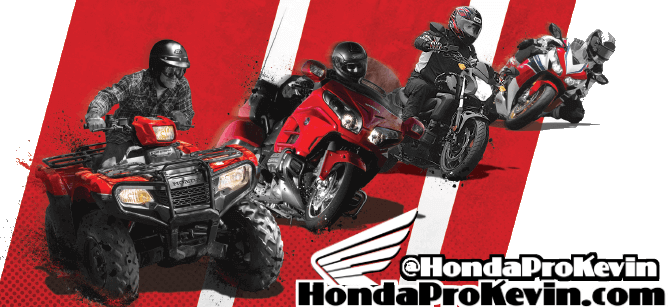



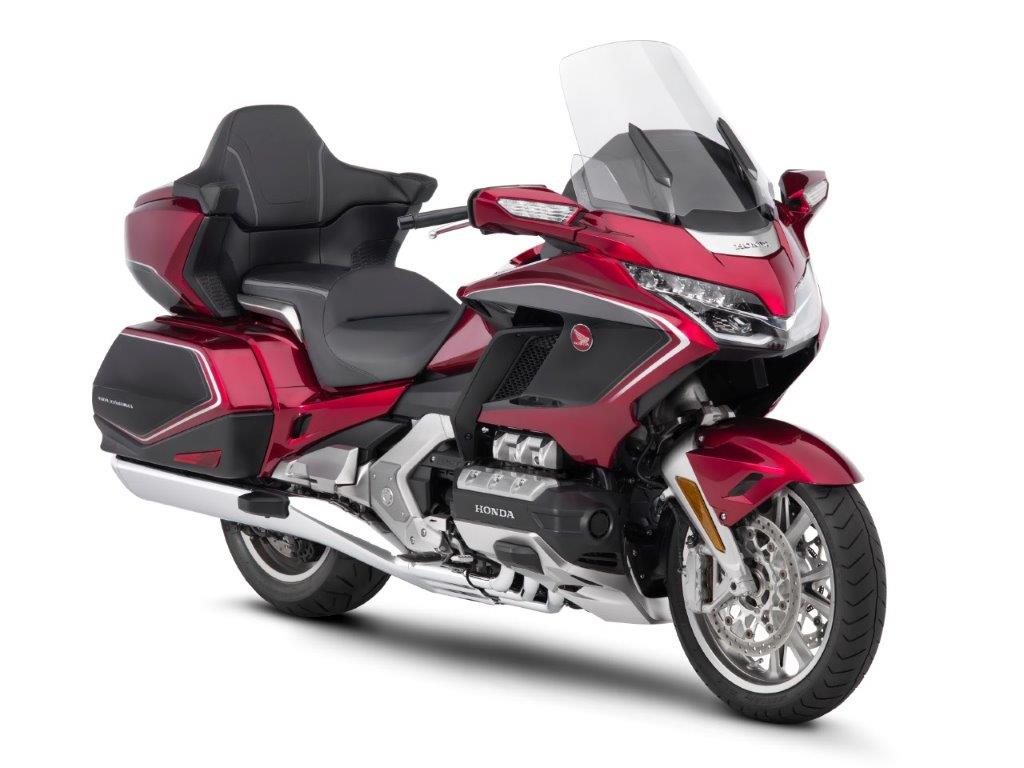
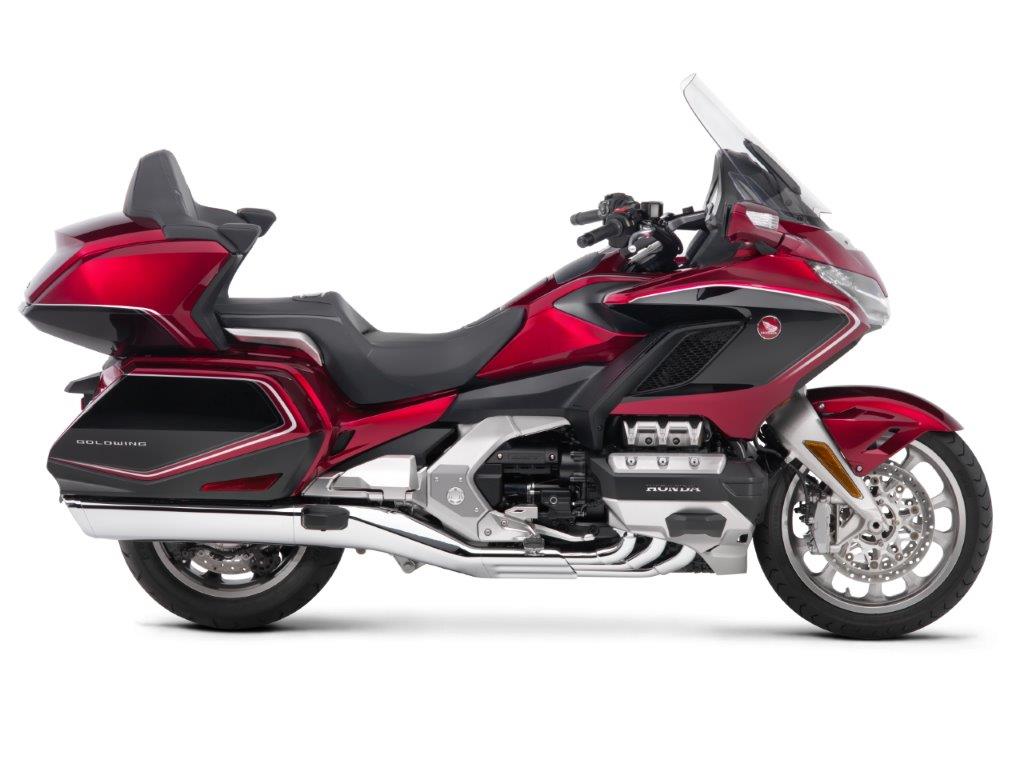

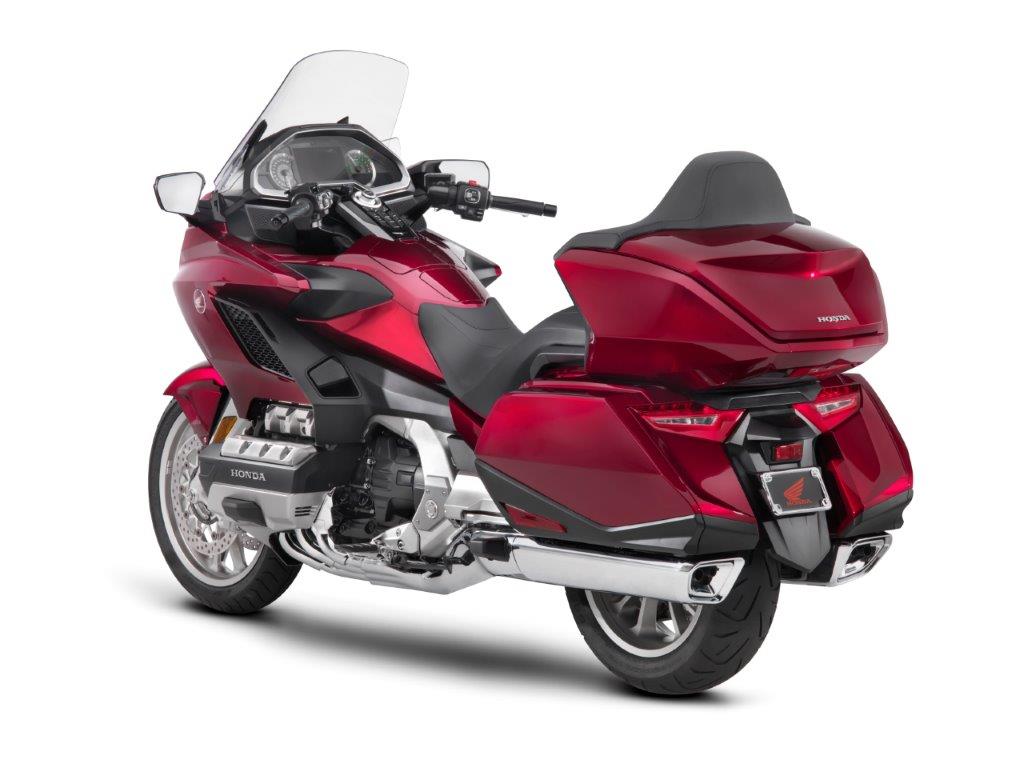
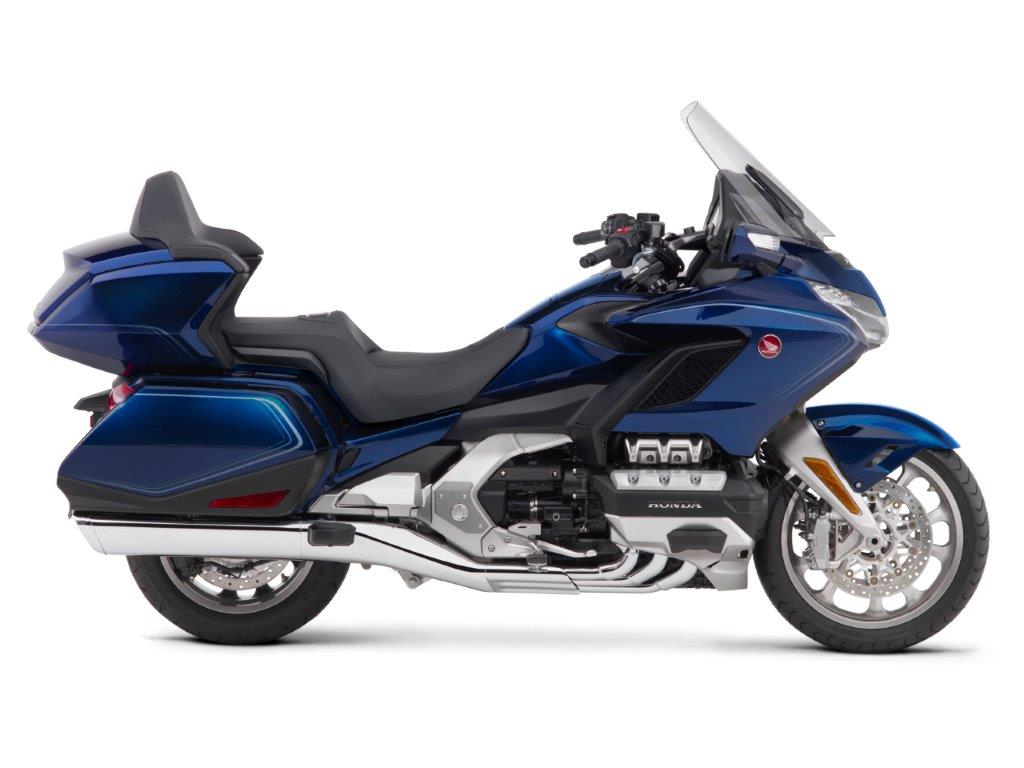
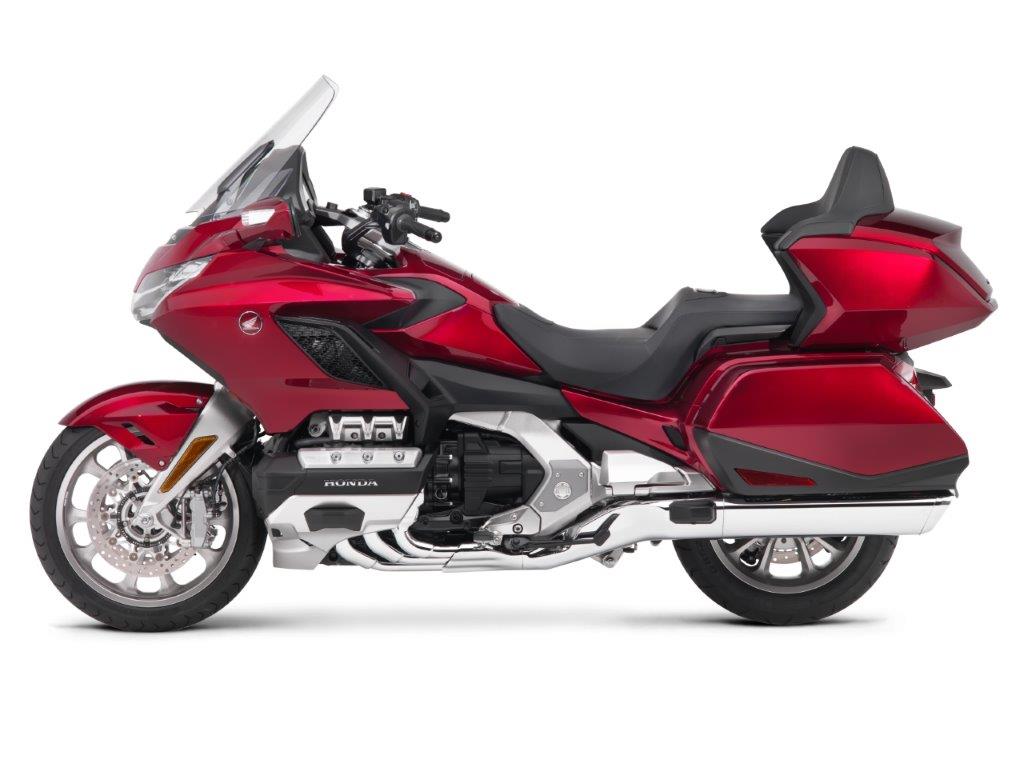
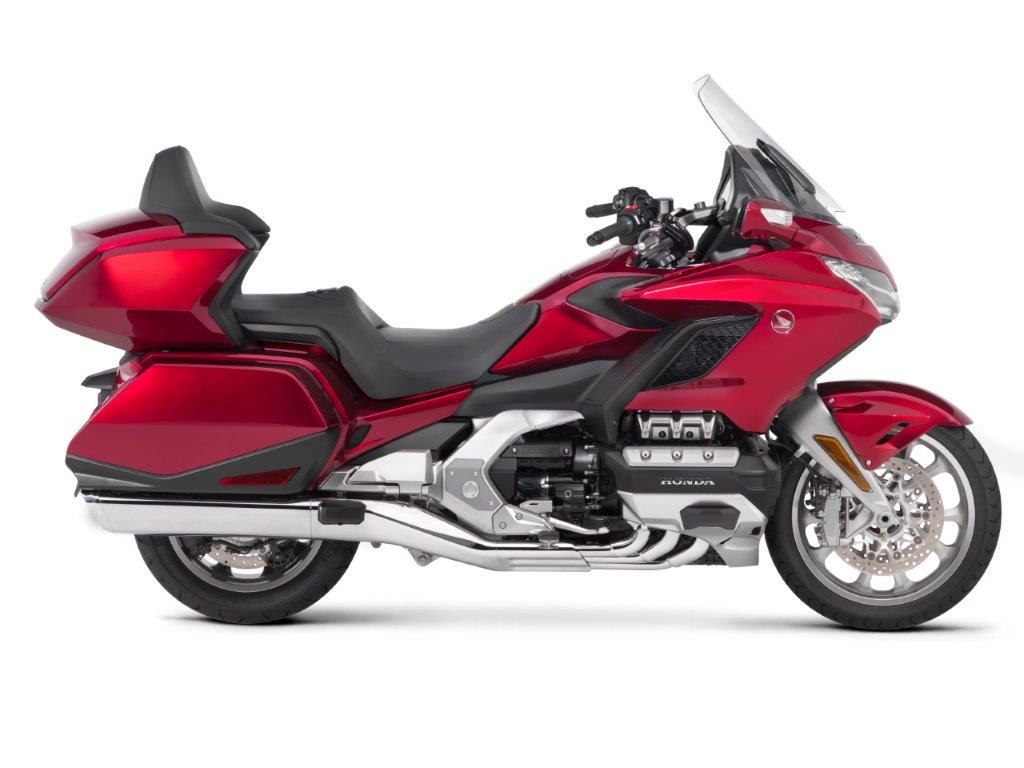
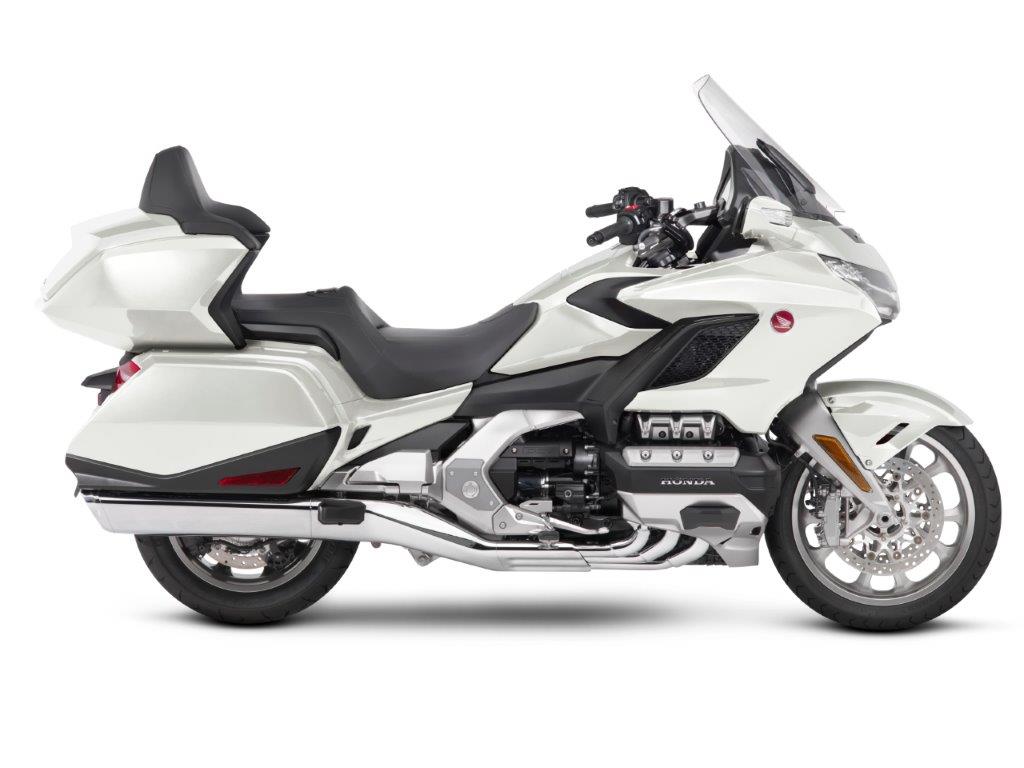

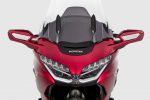
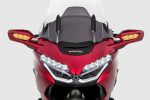
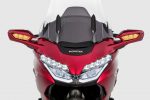
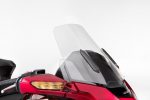
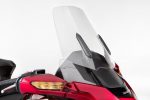
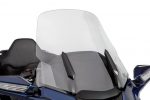
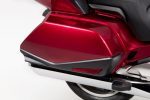
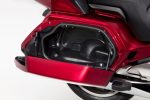
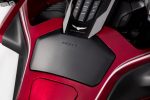
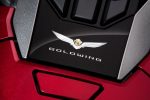
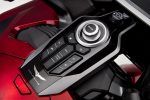
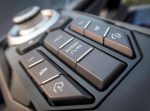
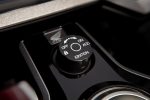
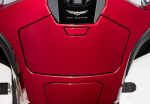
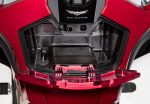
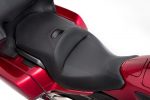
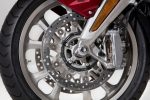
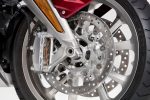
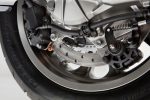

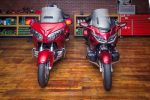
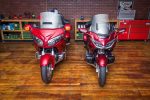



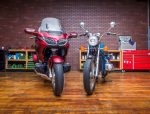


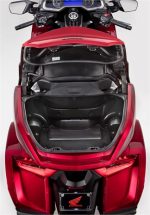





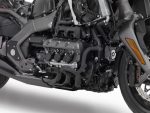
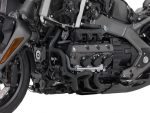
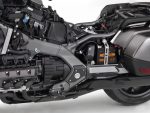
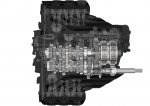
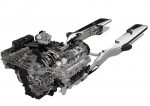
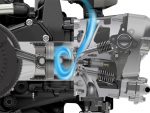
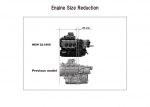
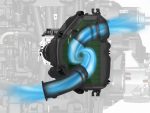
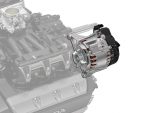
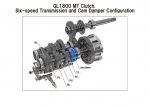
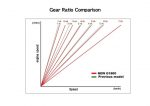
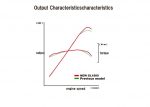
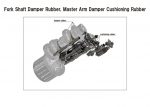
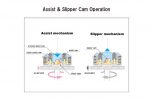
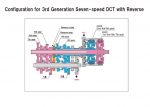
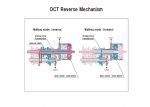
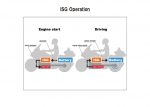
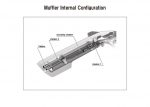
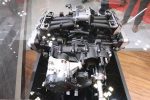
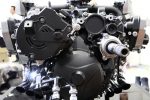
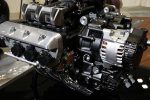
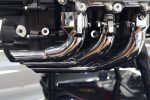
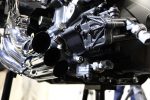
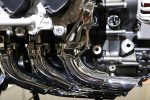
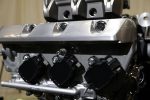
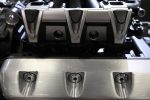


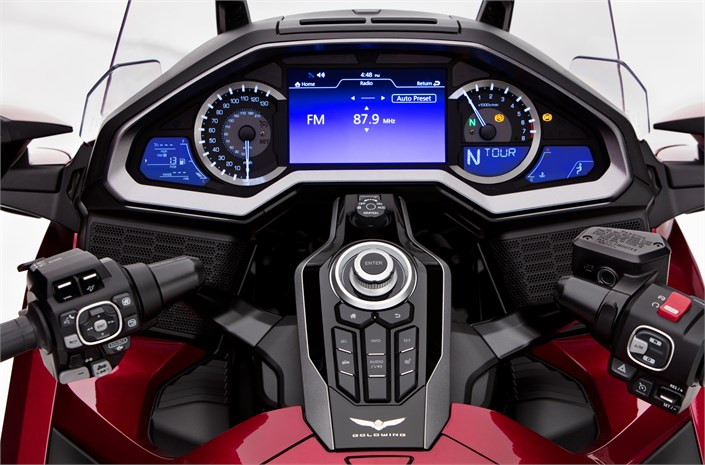
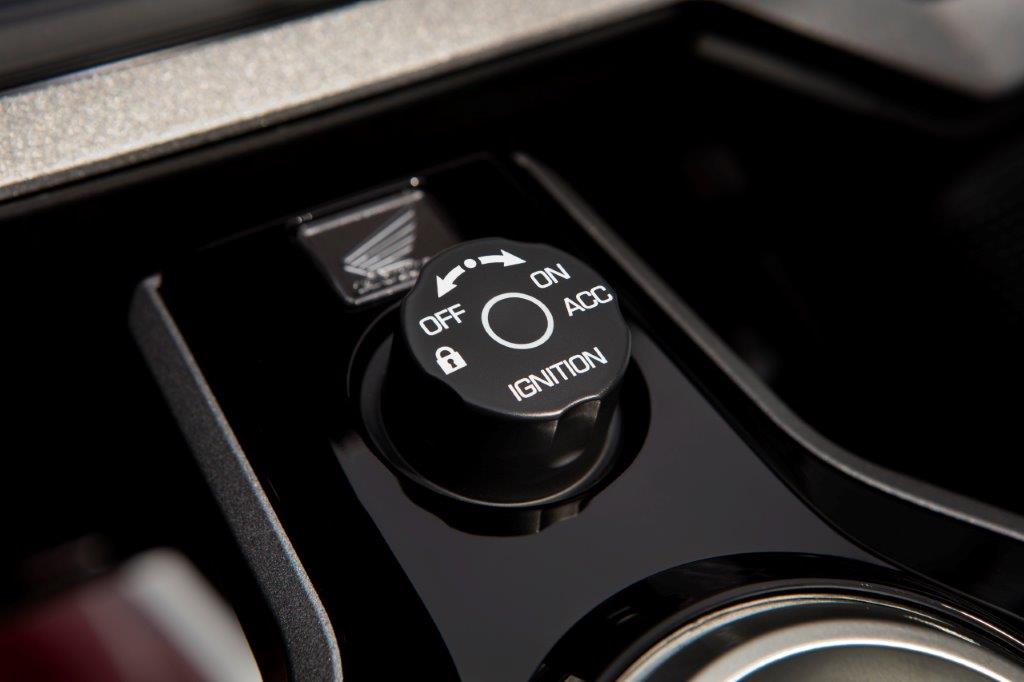
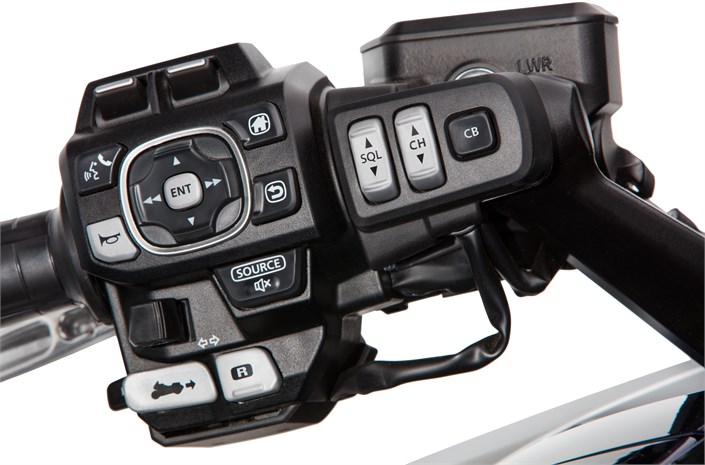
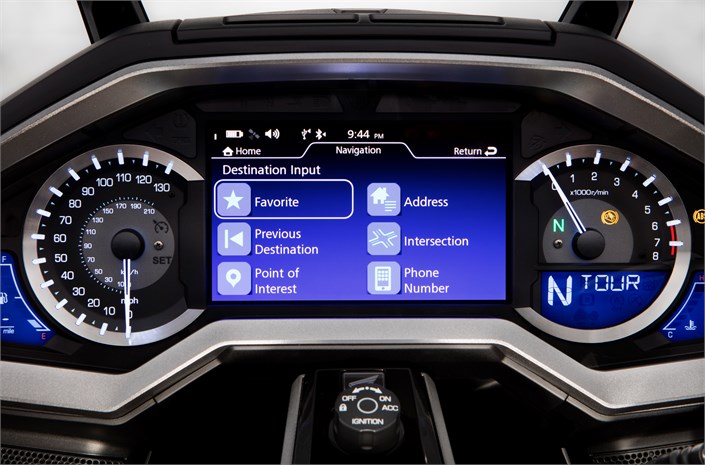
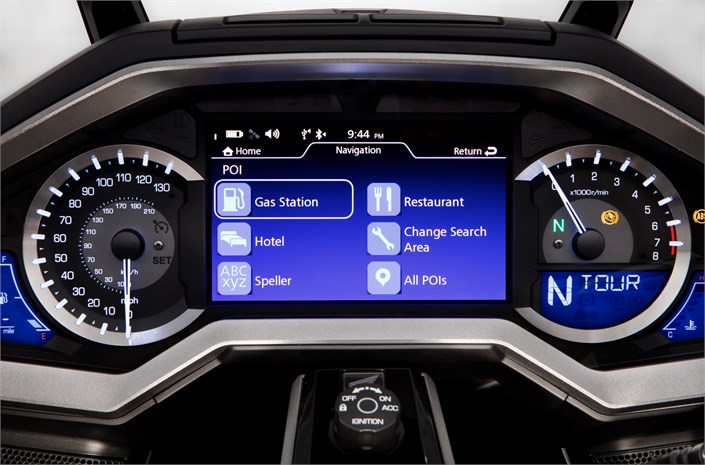
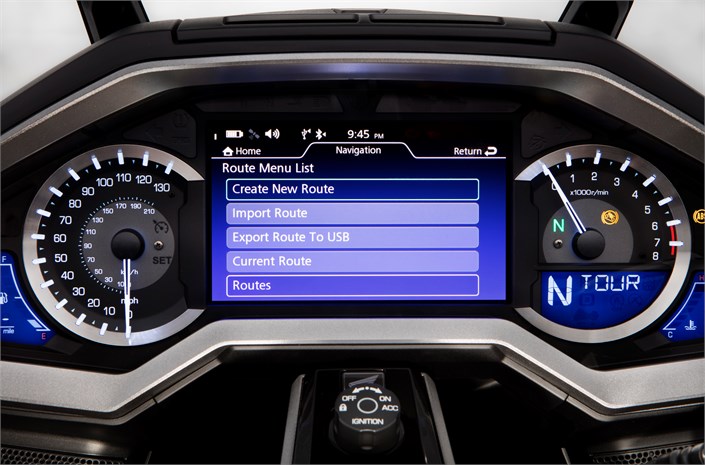
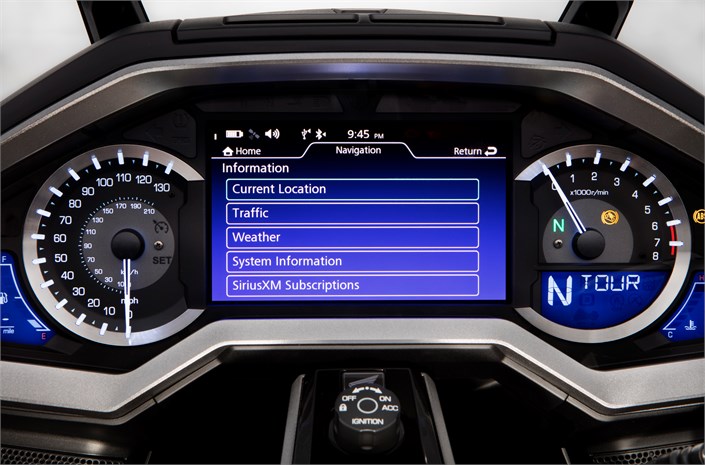
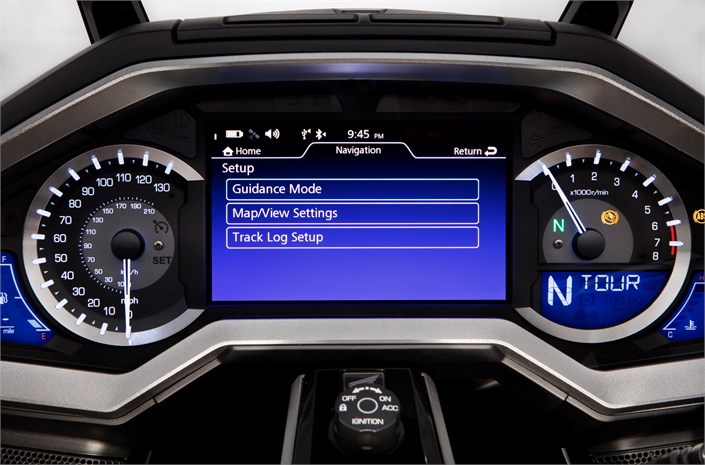
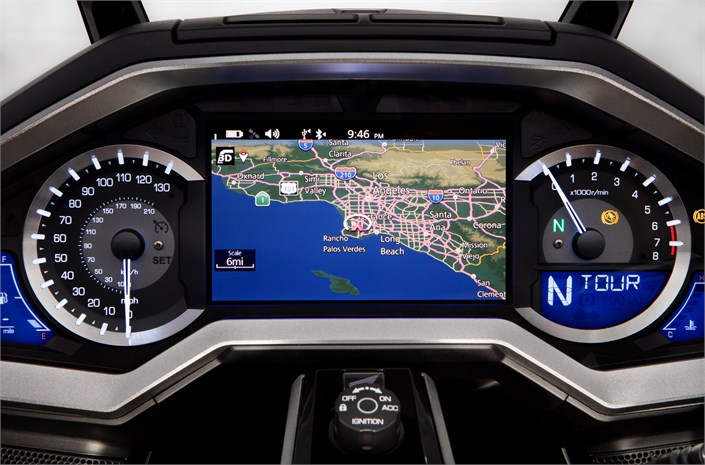
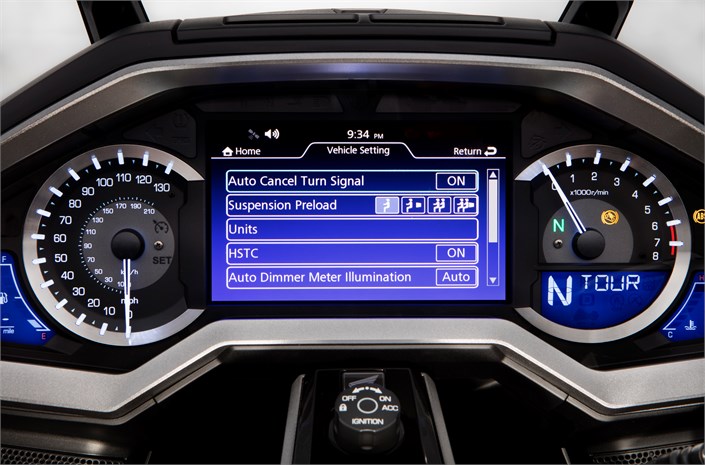
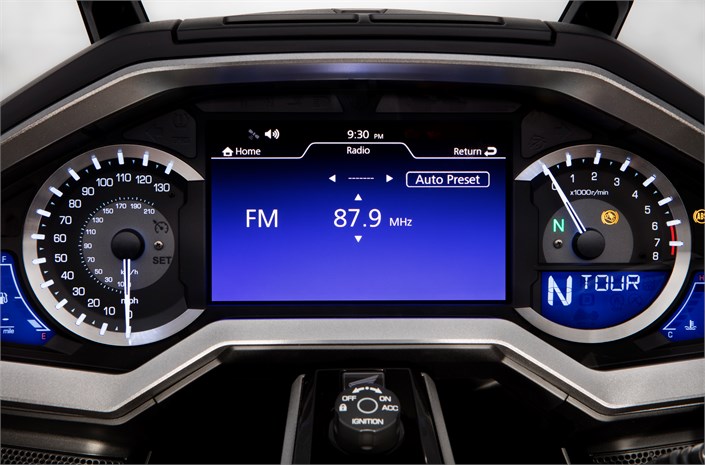

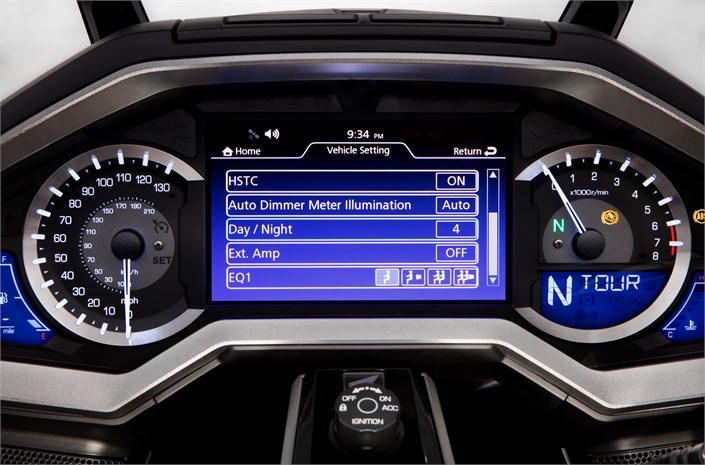
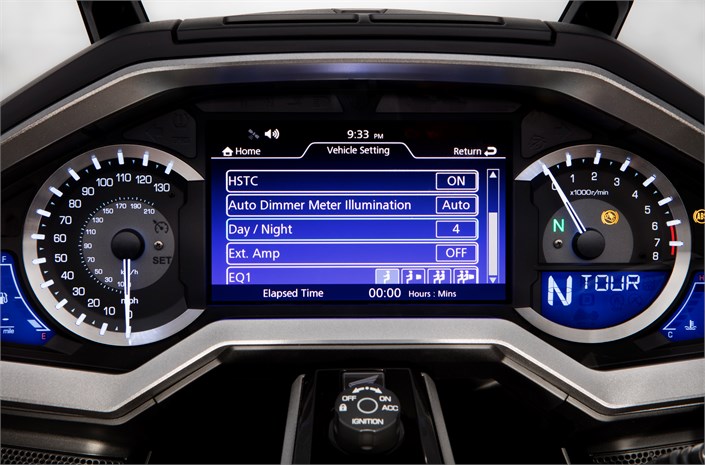
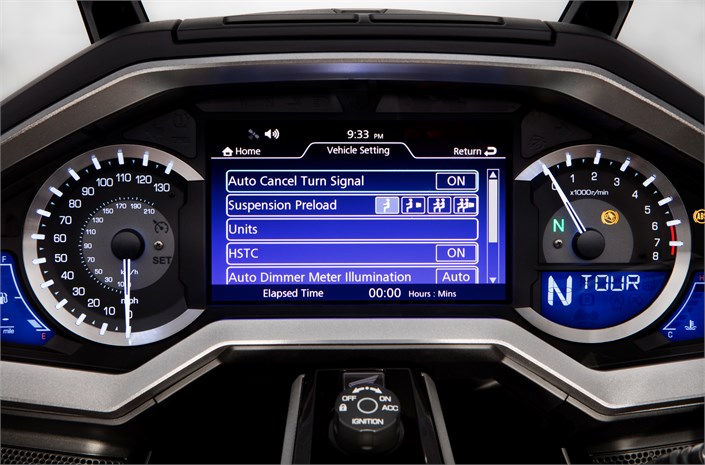
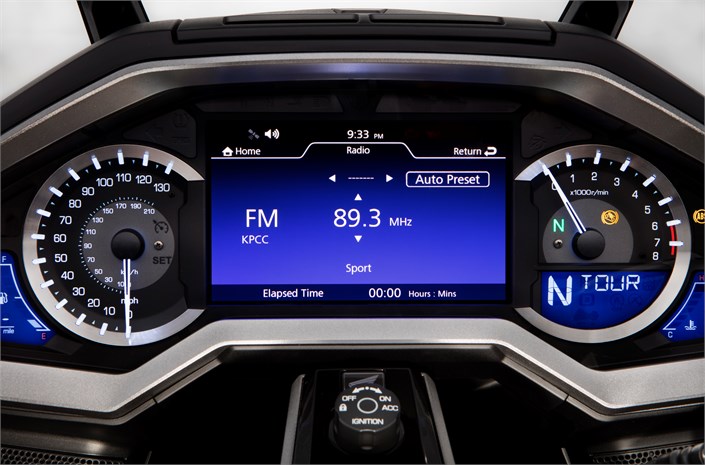
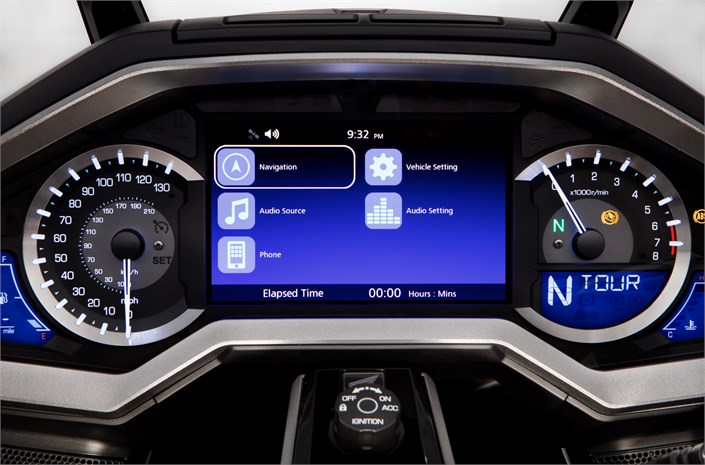
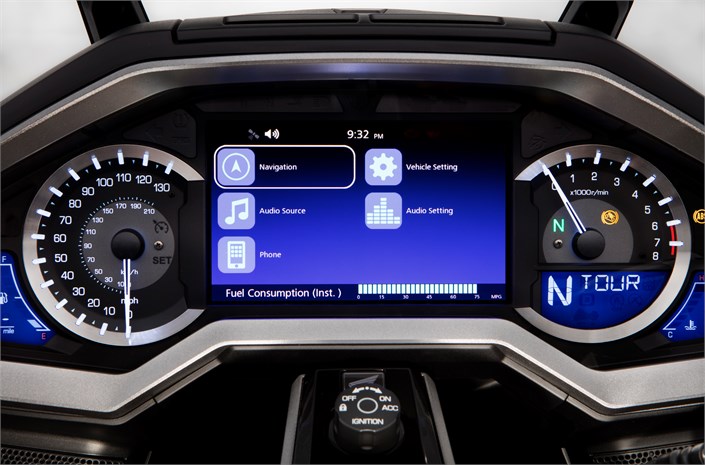
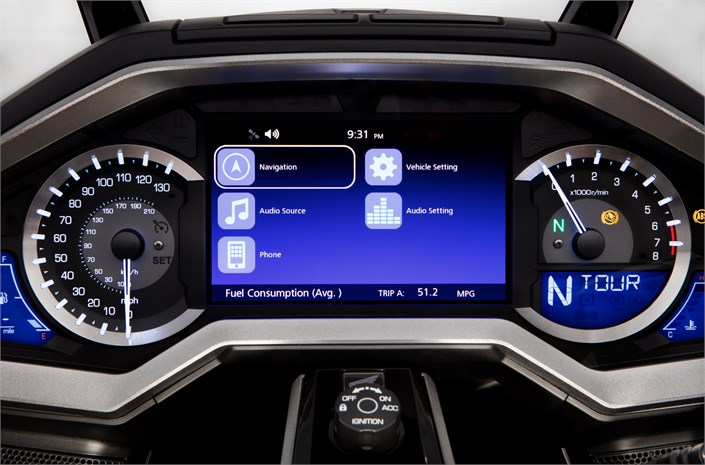
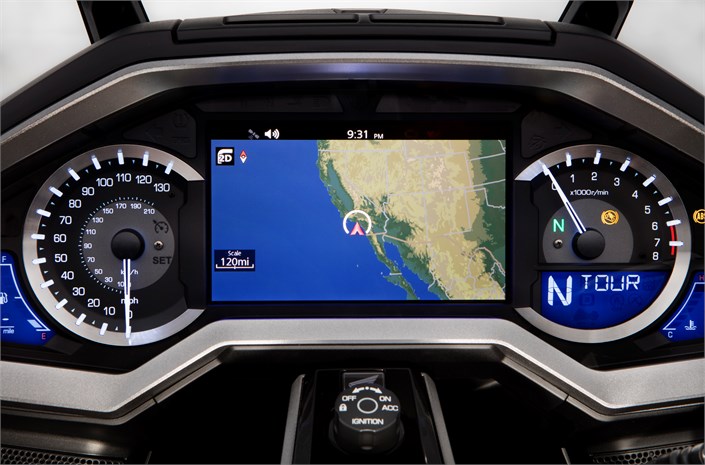
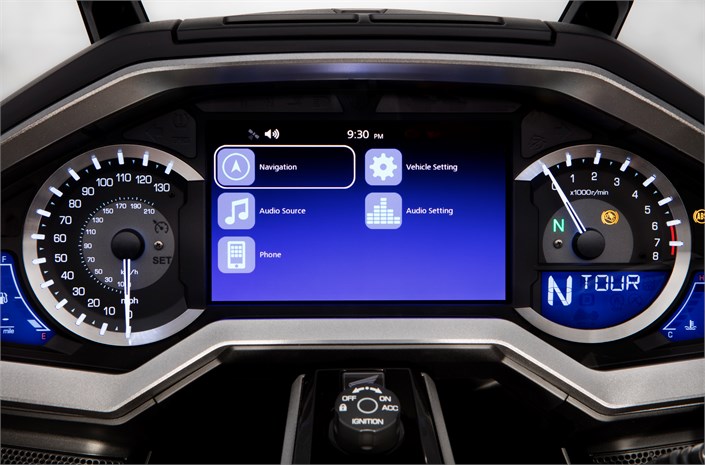
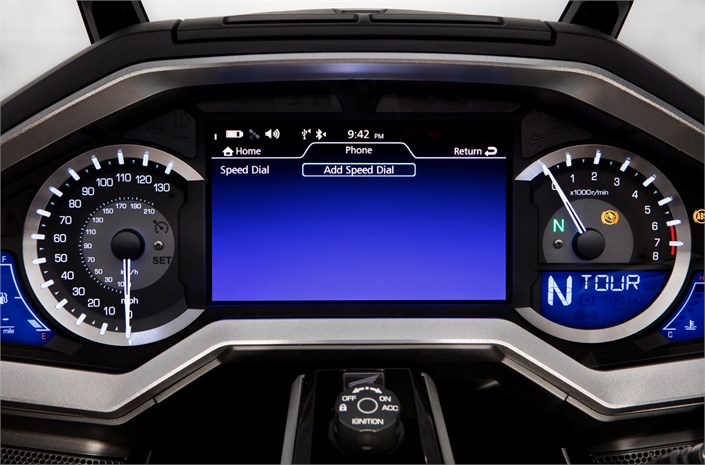
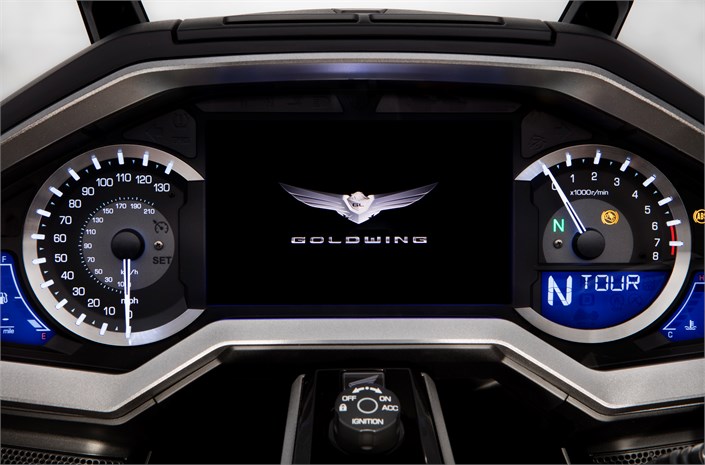
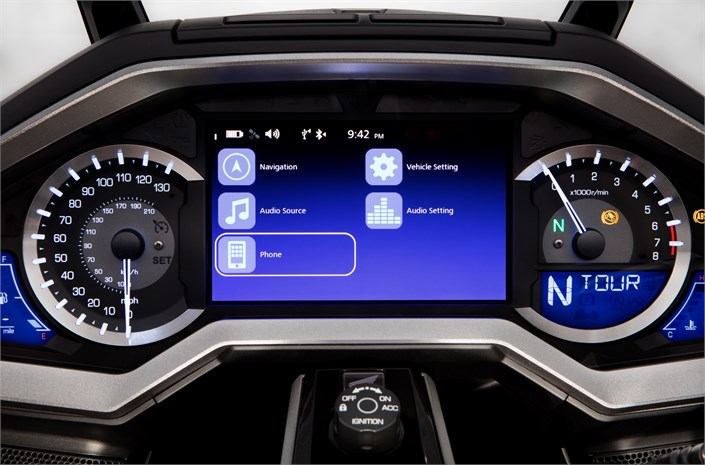
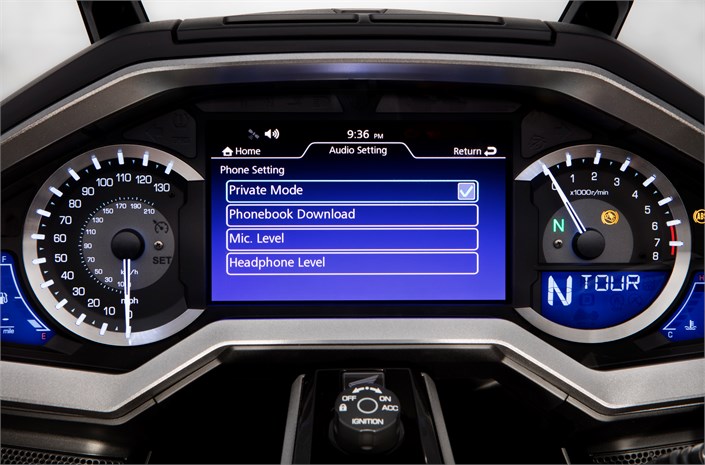
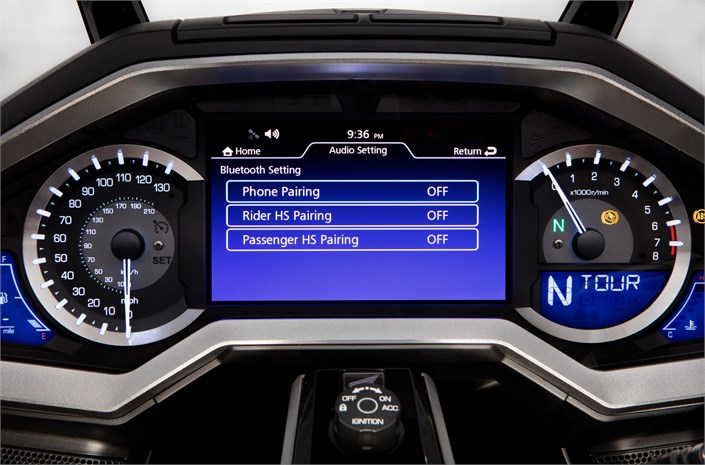
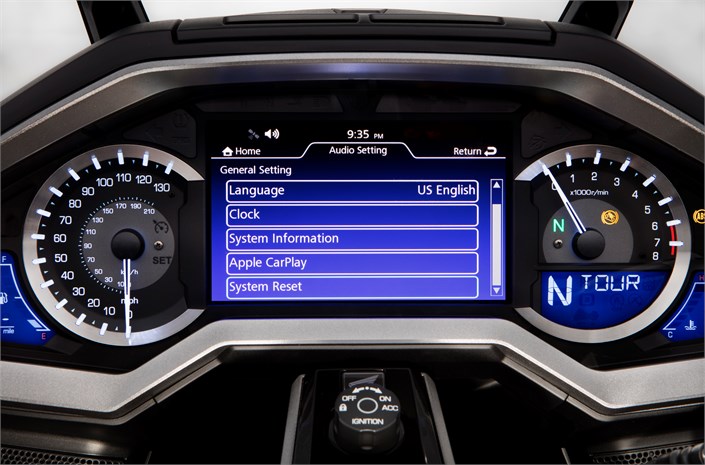
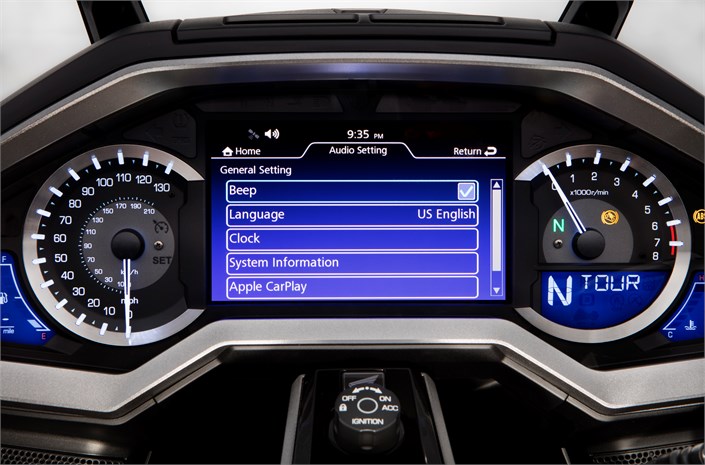
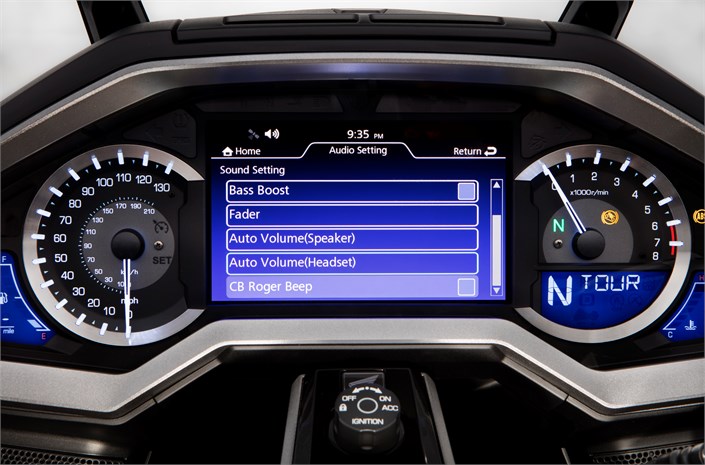
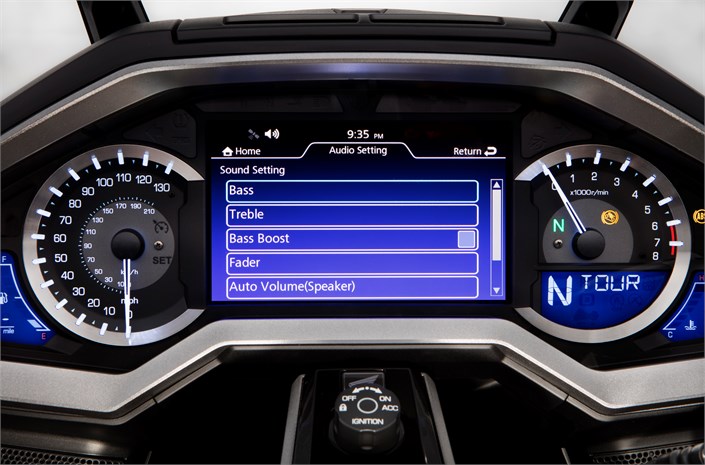
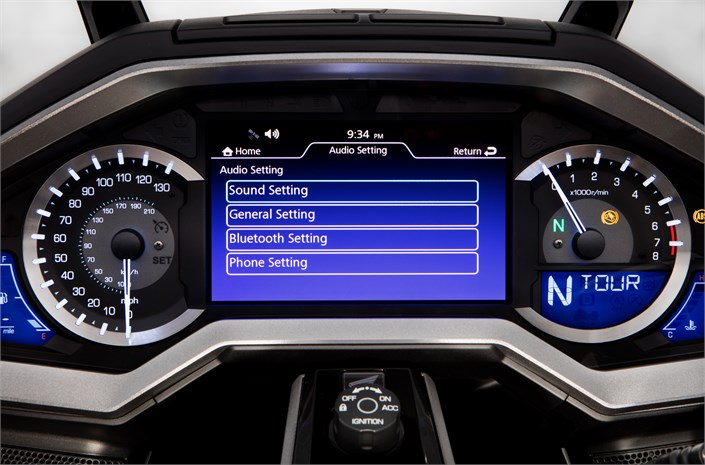
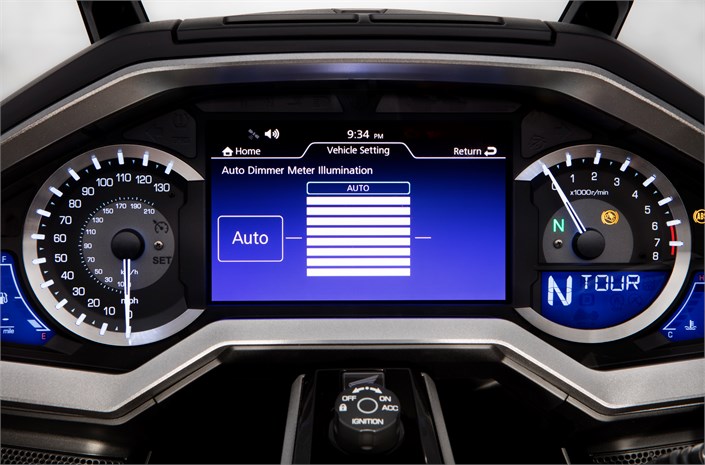
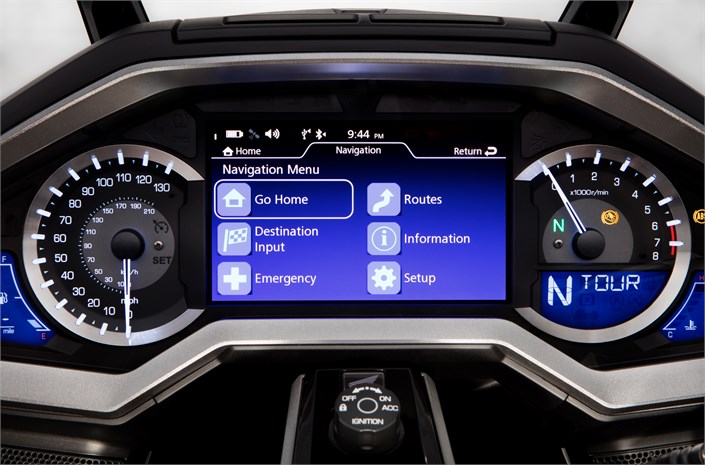
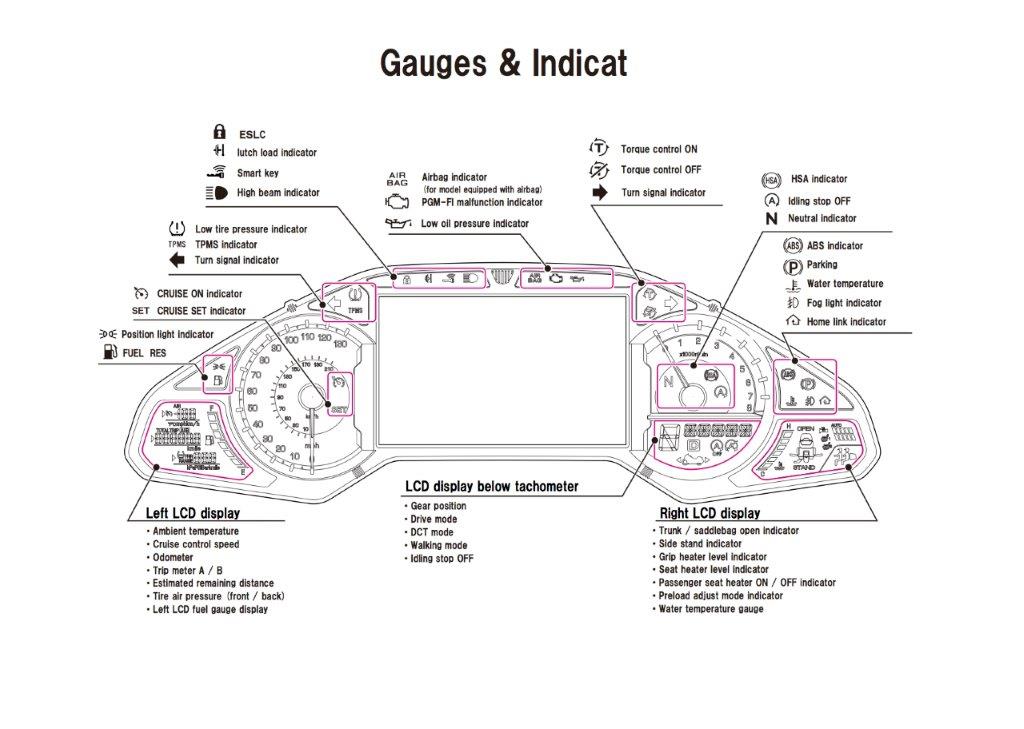
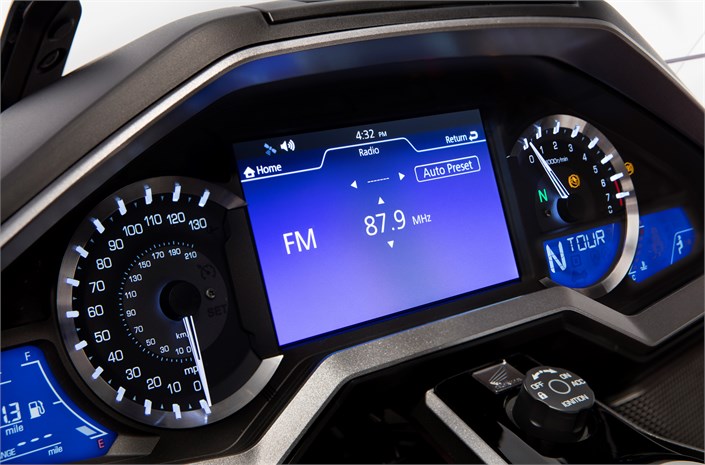
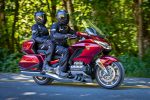

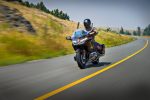
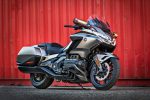
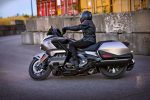
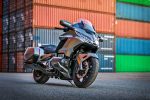
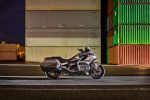

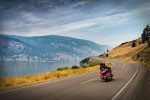
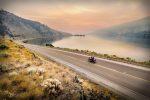
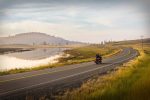
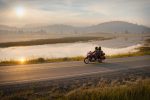
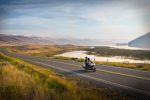


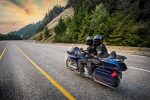


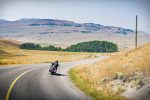

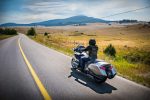


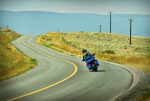
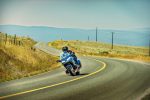

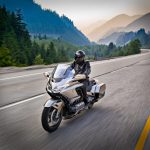
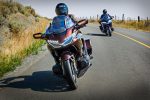
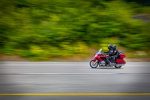

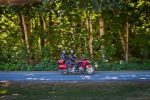
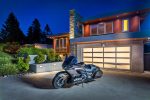
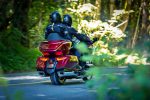



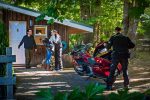
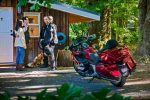
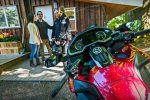
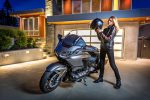
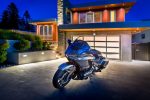
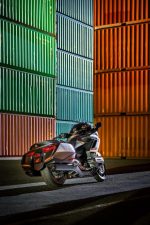


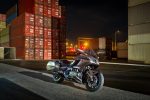
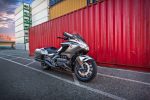

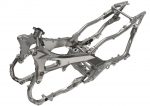
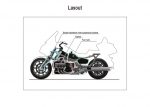
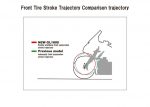
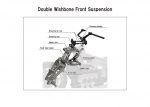
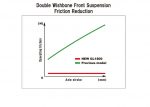
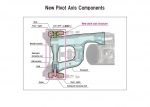
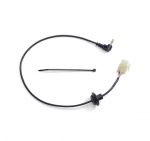

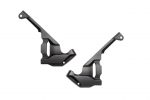
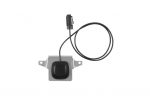
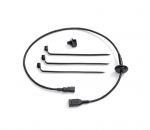
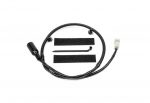
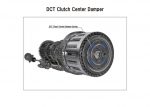
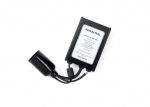

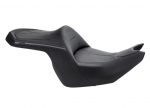
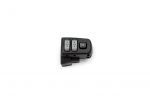
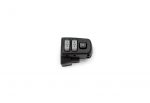
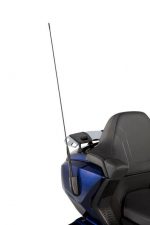
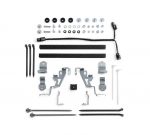
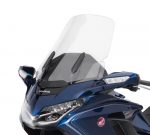
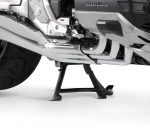
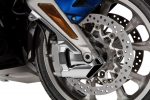
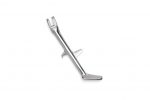
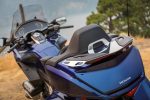
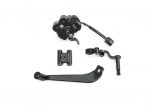
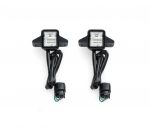
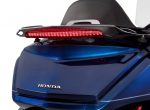
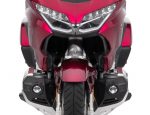
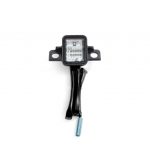
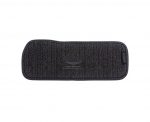
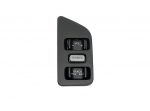

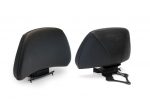
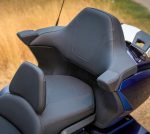
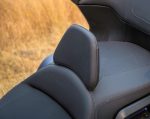
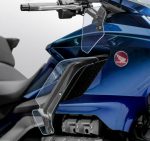
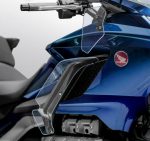
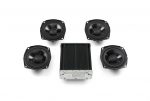
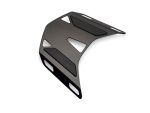

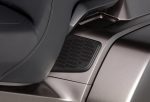
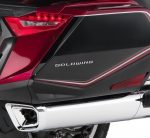

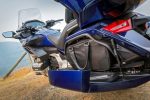
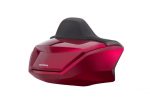
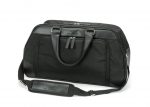
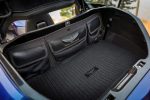

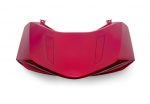
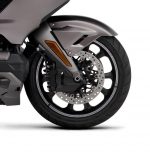
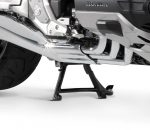



Weight of this bike???
80 to 90 pounds less than the current wing, so figure 850 or so.
It’s in the above chart. 833 for the tour DCT (Non-Airbag)
Does it come with a center stand?
The “Tour” models have a center stand. The standard Wing doesn’t but it is an option.
does the fairing have any storage for phone with power ?
I know it has one small pocket. I also know you can add a cigarette lighter type accessory plug. But I don’t know where it goes. I thought I saw on one of the promo videos someone plugging in a phone… but I’m not sure. I can’t imagine it doesn’t have a USB plug someplace.
Looking forward to learning a bit more:
1) Price list for the accessories. Their website only has a limited listing
2) Is the CB also Bluetooth or do you have to tether yourself back to the bike? And much for the CB set up?
3) Can the cover over the front case protector easily come off so you can add highway pegs?
4) I know the GPS has a big screen, but is it as advanced as the BMW Nav VI? On the BMW you can blue tooth in routes, add GPX files for routes, Share (Bluetooth) routes from bike to bike, Weather, Traffic, Trip Computer, Fuel monitor, Bike stats, add destinations via phone app, etc etc… I know all this is actually Garmin’s handy work in the background. But not sure who worked in the background for Honda and well Honda is known for limiting Garmin’s abilities. And my last Wing had more issues with the GPS than anything else… Hoping for much more than a larger screen (as it relates to GPS functionality)
Well you’very got a beautiful bike with lots of new technology but if everything we use to get standard is an expensive accessory now at $26,700 to $31, 400 plus all the the items like center stands and expensive accessories runs the cost up to $40,000 for a new GLASSES 1800MGW then odds are you have priced yourselves out of the old and young markets and are fixing to eat a lot of extremely nice new bikes that most motorcyclists can’take come close to affording.
I really hate that because I would have loved the newer model even though ya’-llmdidn’the decrease the weight like you said. At over 800 pounds dry weight it’seems still the heaviest bike around and more costly than any other. Guess I’ll just have to stick with my vtx 1800c, it’seems paid for and no way are most of us go8ng to spend that kind of money on a bike. Just keep them in Japan . Harleys are cheap compared to GW. I use to be a GOLDWING ROADRIDES REP several years ago and started a good size chapter and use to promote GOLDWINGS, but I can’tell justify them anymore and now these not A GOLDWING PLANT IN THE USA anymore.
Wish ya’ll luck, you’ll need it, nice bike just way too expensive!
Not sure you are looking at the same bike..lol What features aren’t included that are on the previous bikes? Centerstand? That’s only on the Bagger Gold Wings. My F6B Standard didn’t come with one. I did add one from a new take off trike conversion. Sure there will be some of those as soon as the trike conversions start. As far as other features, these bikes have way more than the current offerings do stock. Every trim level includes navigation, heated grips and on and on. Just a little confused by your posts.
How is this a young persons touring bike? Stratospherically priced flagship for young riders? Looks like features like creep/walk mode in DCT wings are for old people with arthritic joints 🙂
If Honda needs younger folks it also needs a middle of the market tourer: something in the 12000-18000 dollar range. Revamp the NT700 with touring essentials such as cruise, heated grips and 1-up touring capability. Now that would bring younger riders into their fold and feed into their future Goldwing customer base. As of right now, they have left that market open for the competition.
For long Honda has equated luxury( with features such as cruise, audio and nav) and has refused to offer them on anything but their flagship offering. These may have been luxuries at the time of GL1500 launch but is now considered essential for any touring bike. This has been their biggest mistake based on their fear that it will poach from GoldWing sales. But having such an offering entices young touring riders into their fold who will make the transition to the GoldWing as they get along in their life.